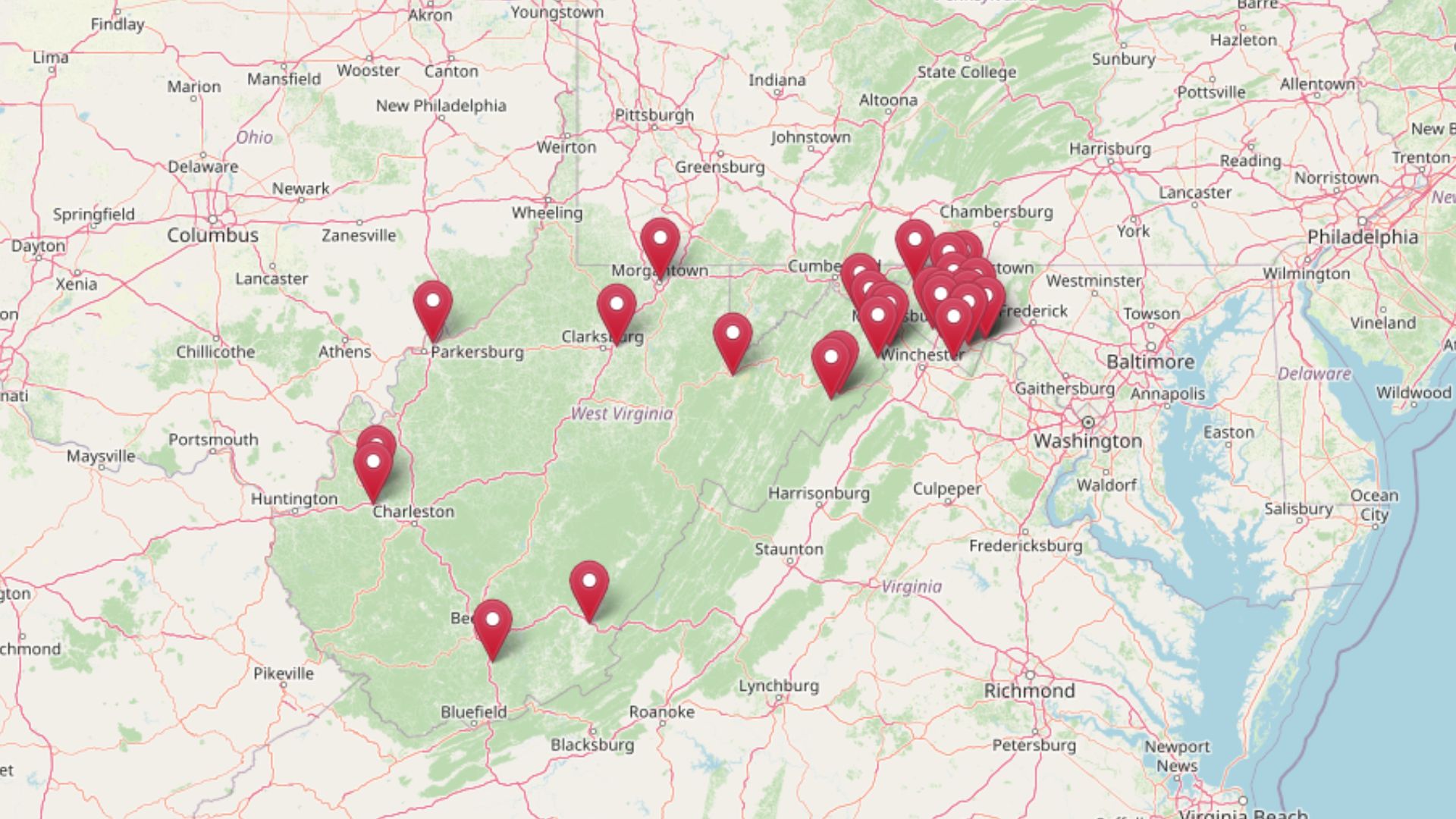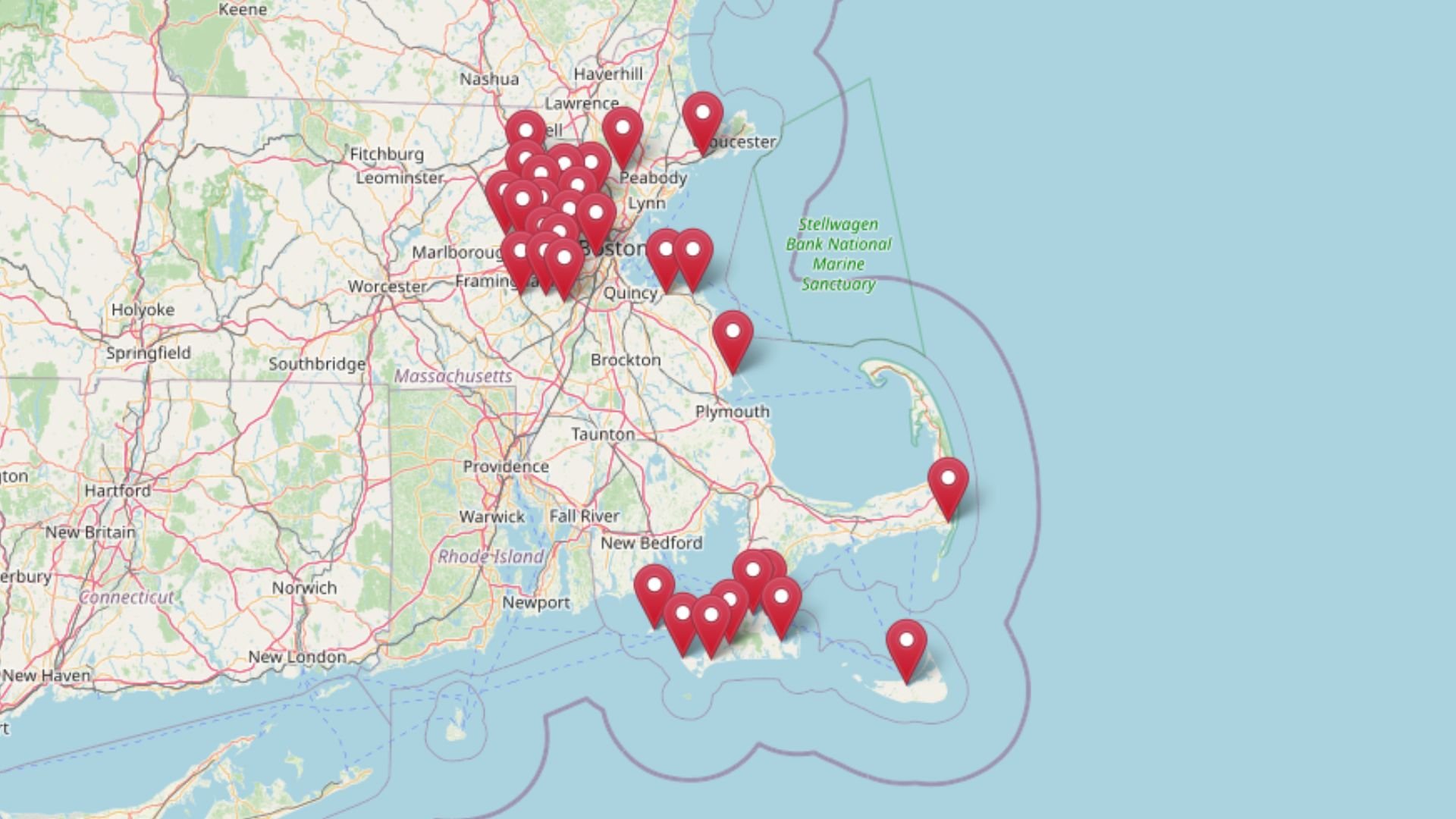
Using the latest Zillow Home Value Index, we’ve ranked the 30 most expensive towns in Massachusetts based on current home prices. These communities represent the pinnacle of Bay State real estate, with median values ranging from just over $1 million to nearly $3 million. Each town tells its own story of sustained growth, geographic advantage, and buyer demand.
From island retreats where privacy commands a premium to suburban enclaves with top-rated schools, these markets have weathered economic shifts while maintaining their elite status. The data reveals dramatic price increases since 2010, with some communities seeing home values more than double over the past 15 years. Understanding these trends offers valuable insight into Massachusetts’ most coveted residential markets.
30. Lynnfield – 116% Home Price Increase Since 2010
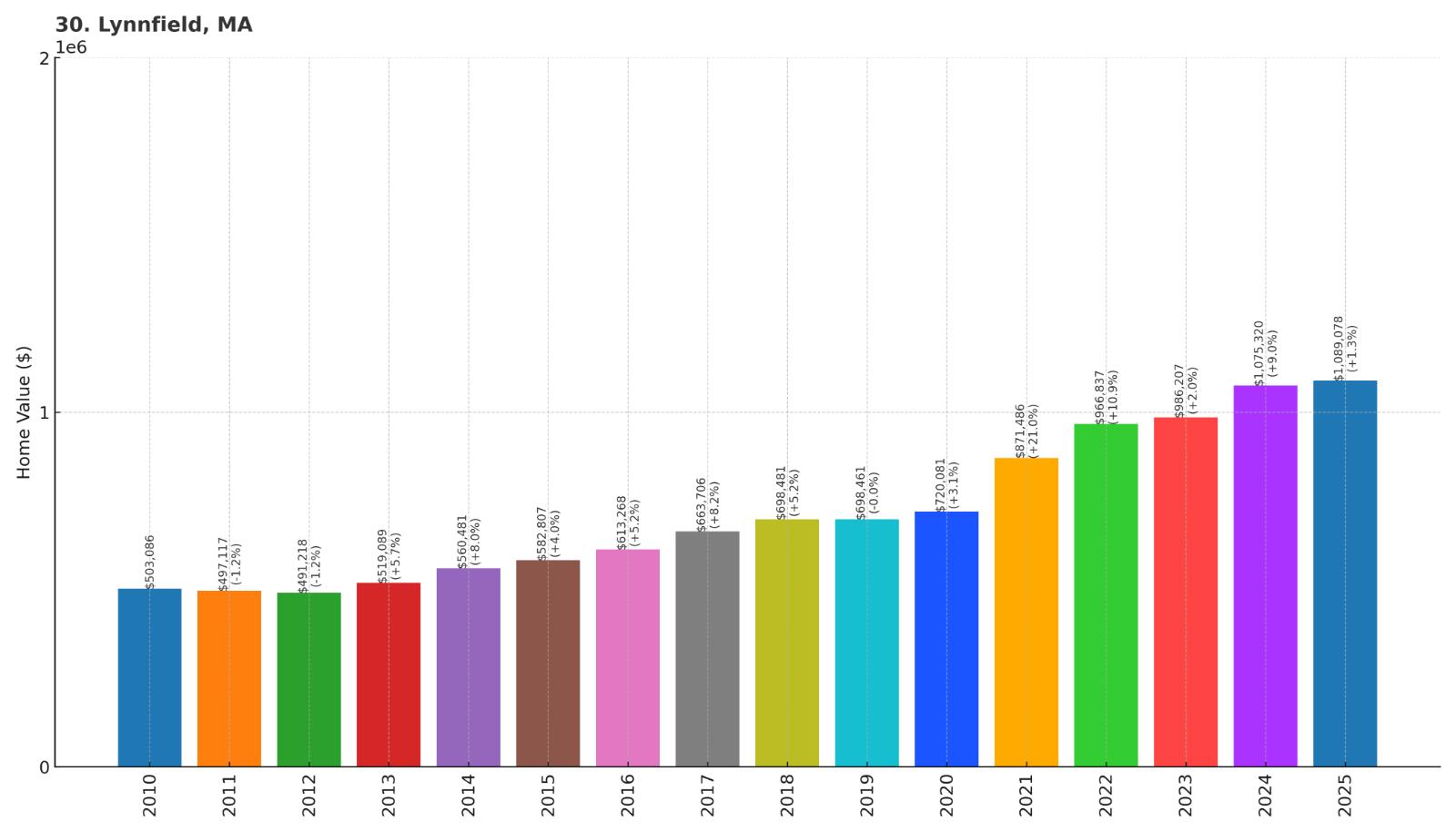
- 2010: $503,086
- 2011: $497,117
- 2012: $491,218
- 2013: $519,089
- 2014: $560,481
- 2015: $582,807
- 2016: $613,268
- 2017: $663,706
- 2018: $698,481
- 2019: $698,461
- 2020: $720,081
- 2021: $871,486
- 2022: $966,837
- 2023: $986,207
- 2024: $1,075,320
- 2025: $1,089,078
Lynnfield has doubled its home values since 2010, with the most dramatic surge occurring during the pandemic years. The town reached the million-dollar threshold in 2024 and continues climbing toward $1.1 million. This steady appreciation reflects strong buyer interest in this North Shore community’s combination of suburban amenities and proximity to Boston.
Why Lynnfield?
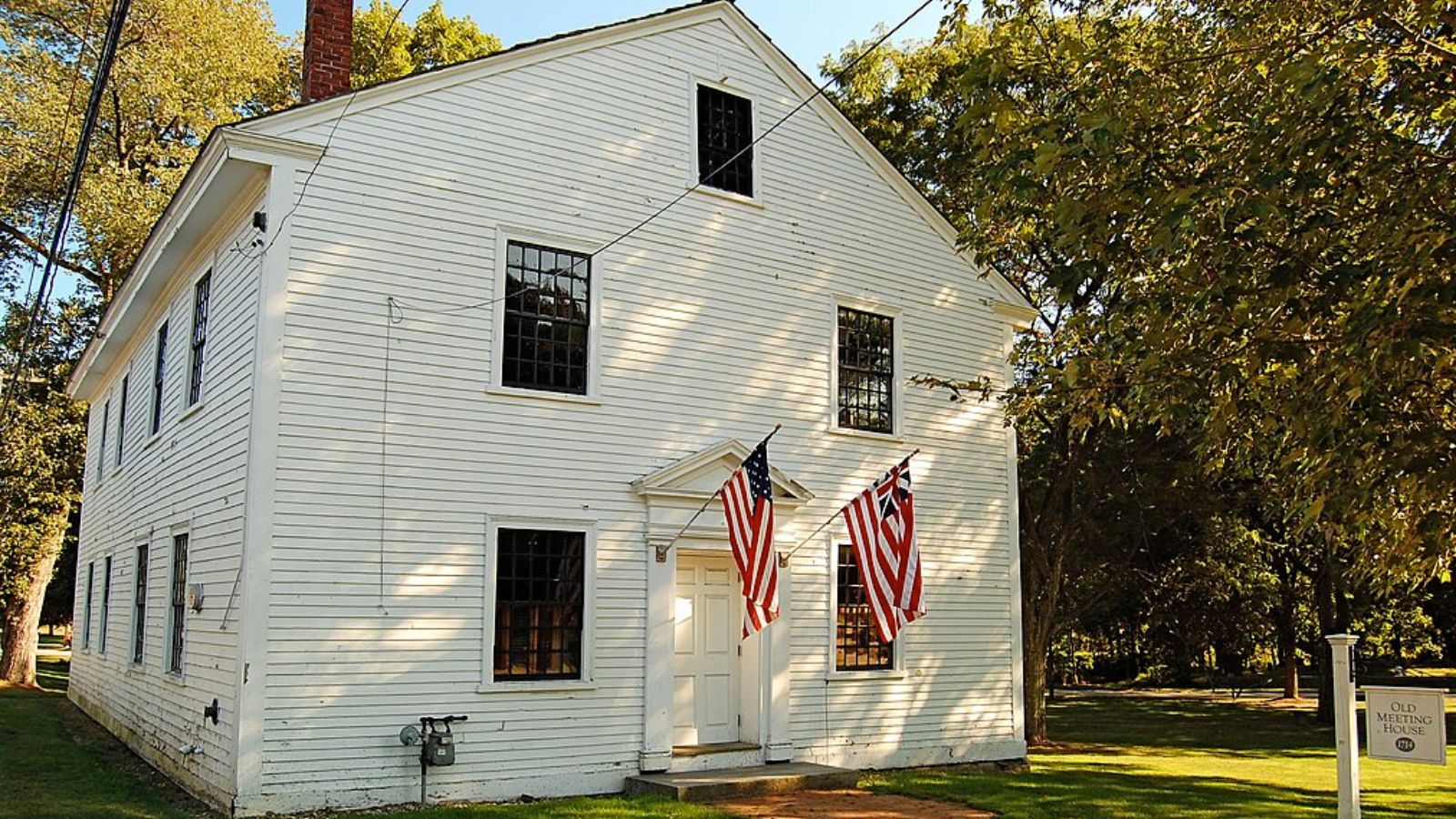
Why Are People Willing to Pay So Much to Live Here? What’s Special About It?
Families choose Lynnfield for its excellent public schools and small-town atmosphere within commuting distance of Boston. The town offers large residential lots, well-maintained neighborhoods, and access to recreational facilities including golf courses and conservation land. Lynnfield’s location provides easy access to Route 95 and Route 1, making it attractive to professionals working in Boston or the North Shore.
How Lynnfield Rose to Prominence
Originally settled in the 1600s as part of Lynn, Lynnfield became an independent town in 1814 when residents sought better representation and local control. The community remained largely agricultural until the mid-20th century when suburban development transformed it into a residential enclave. The town’s proximity to major highways and employment centers in Boston made it increasingly desirable as families sought larger homes and better schools outside the city.
3 Interesting Tidbits
1. MarketStreet Shopping: The town is home to MarketStreet Lynnfield, a major outdoor shopping and dining destination that serves the entire North Shore region.
2. Reedy Meadow Golf Course: This public 18-hole golf course has been a community centerpiece since 1957, offering recreation and events for residents.
3. Split Rock Conservation Area: The town maintains over 200 acres of conservation land with trails and natural areas that preserve Lynnfield’s rural character.
29. Duxbury – 101% Home Price Increase Since 2010
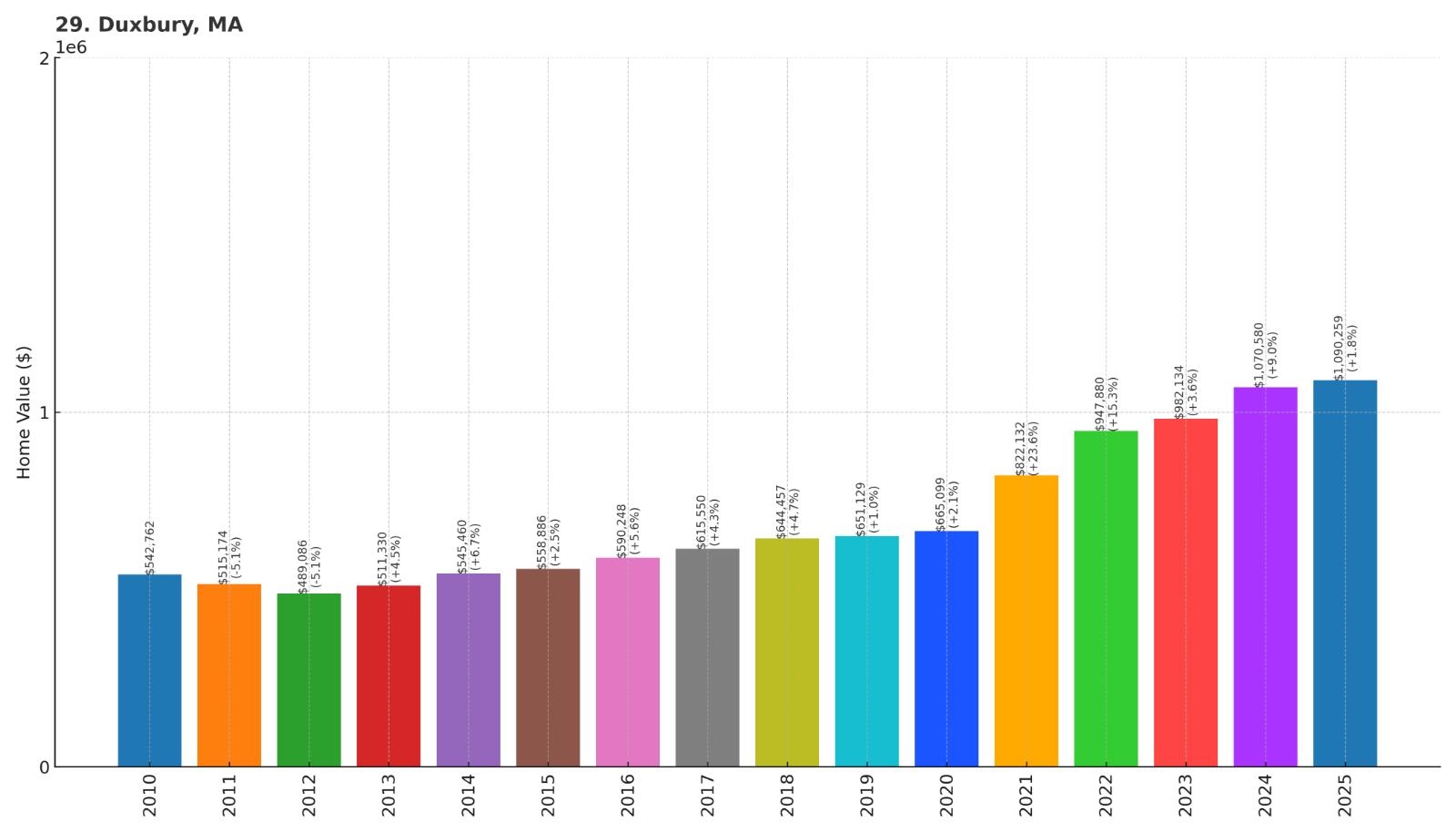
- 2010: $542,762
- 2011: $515,174
- 2012: $489,086
- 2013: $511,330
- 2014: $545,460
- 2015: $558,886
- 2016: $590,248
- 2017: $615,550
- 2018: $644,457
- 2019: $651,129
- 2020: $665,099
- 2021: $822,132
- 2022: $947,880
- 2023: $982,134
- 2024: $1,070,580
- 2025: $1,090,259
Duxbury’s home values have exactly doubled since 2010, with particularly strong growth after 2020. The coastal town crossed the million-dollar median mark in 2024 and shows no signs of slowing. This South Shore community has maintained consistent appeal through economic cycles, driven by its coastal location and historic character.
Why Duxbury?
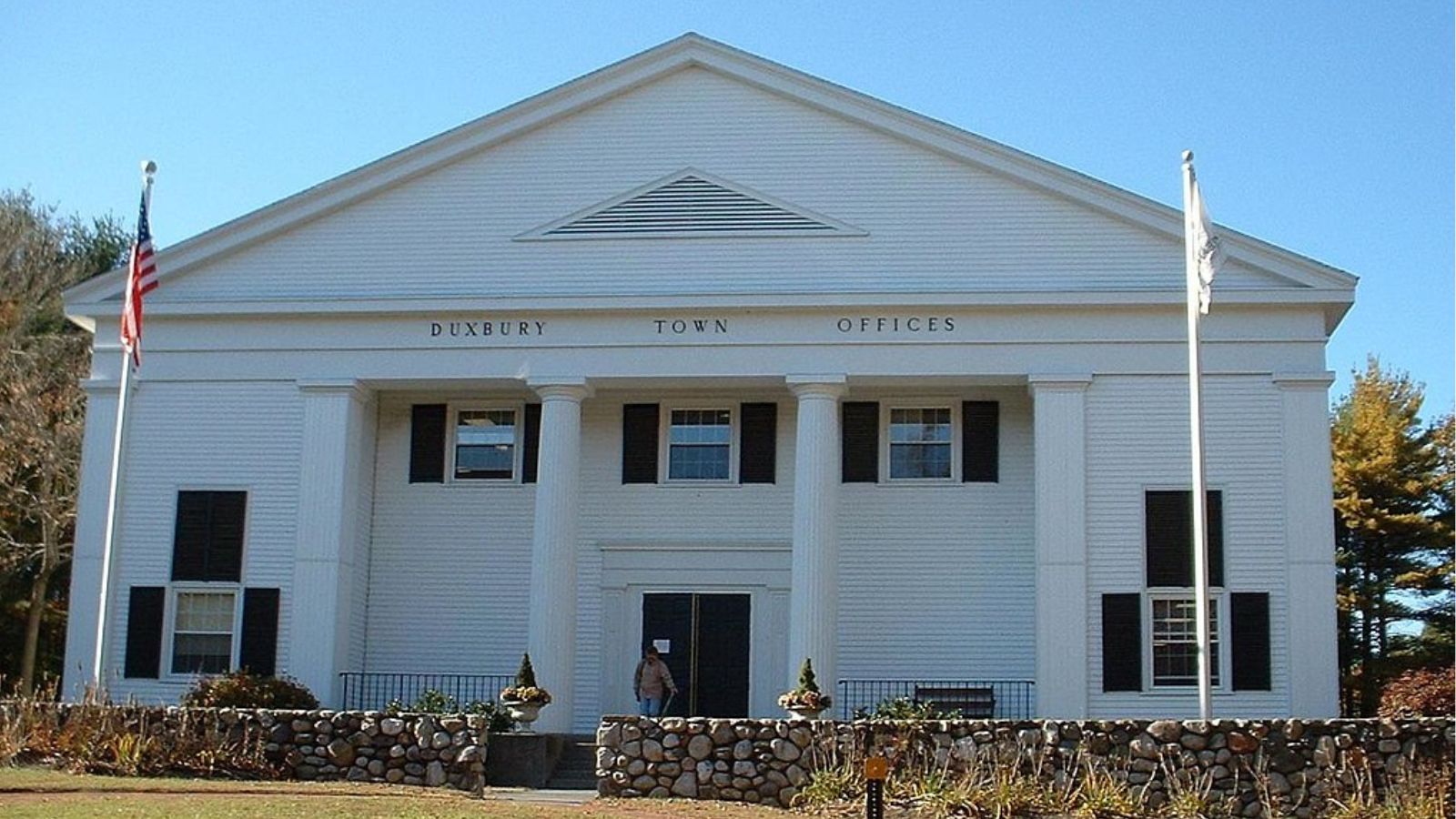
Why Are People Willing to Pay So Much to Live Here? What’s Special About It?
Duxbury combines coastal living with suburban convenience, offering residents beaches, harbors, and maritime activities alongside top-rated schools. The town’s historic district preserves colonial-era architecture while newer developments provide modern amenities. Families value the strong sense of community, excellent public services, and recreational opportunities ranging from sailing to hiking.
How Duxbury Rose to Prominence
Founded in 1637 by Pilgrims from Plymouth Colony, Duxbury was named after the English estate of Myles Standish. The town developed as a maritime community with shipbuilding, fishing, and agriculture as primary industries. In the 20th century, improved transportation links to Boston transformed Duxbury into a sought-after residential community where professionals could enjoy coastal living while maintaining city careers.
3 Interesting Tidbits
1. Duxbury Beach: The town’s 4-mile barrier beach is accessible only by a narrow causeway and offers some of the most pristine coastal scenery on the South Shore.
2. King Caesar House: This Federal-style mansion built in 1809 now serves as a museum showcasing the town’s maritime heritage and colonial history.
3. Cranberry Bogs: Duxbury is home to working cranberry bogs that continue the agricultural traditions established by early settlers centuries ago.
28. Sudbury – 87% Home Price Increase Since 2010
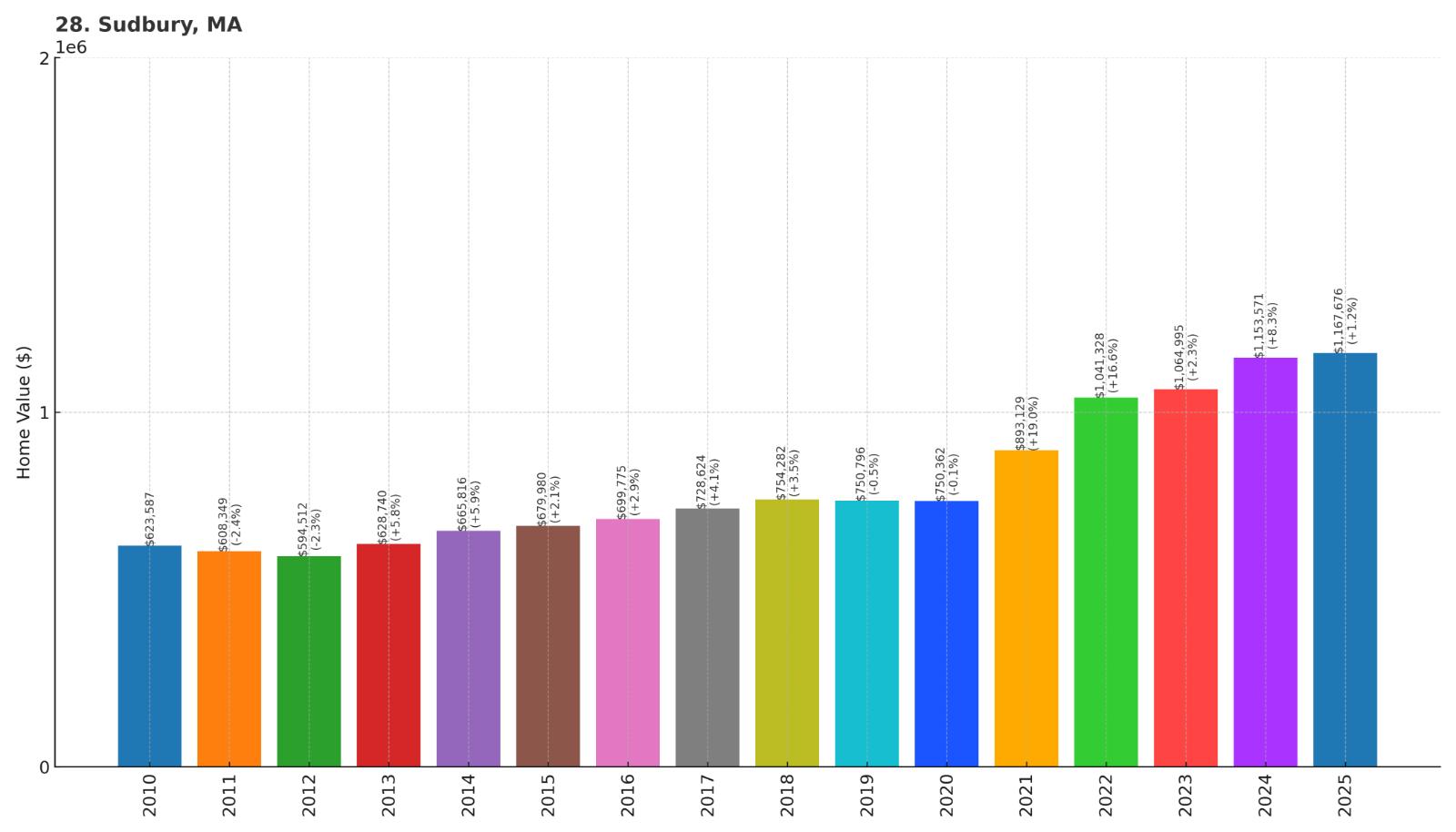
- 2010: $623,587
- 2011: $608,349
- 2012: $594,512
- 2013: $628,740
- 2014: $665,816
- 2015: $679,980
- 2016: $699,775
- 2017: $728,624
- 2018: $754,282
- 2019: $750,796
- 2020: $750,362
- 2021: $893,129
- 2022: $1,041,328
- 2023: $1,064,995
- 2024: $1,153,571
- 2025: $1,167,676
Sudbury has seen steady growth in home values, nearly doubling since 2010 to reach $1.17 million by 2025. The town experienced a significant acceleration in 2021-2022, jumping from $750,000 to over $1 million in just two years. This MetroWest community benefits from excellent schools and convenient access to Boston’s tech corridor.
Why Sudbury?
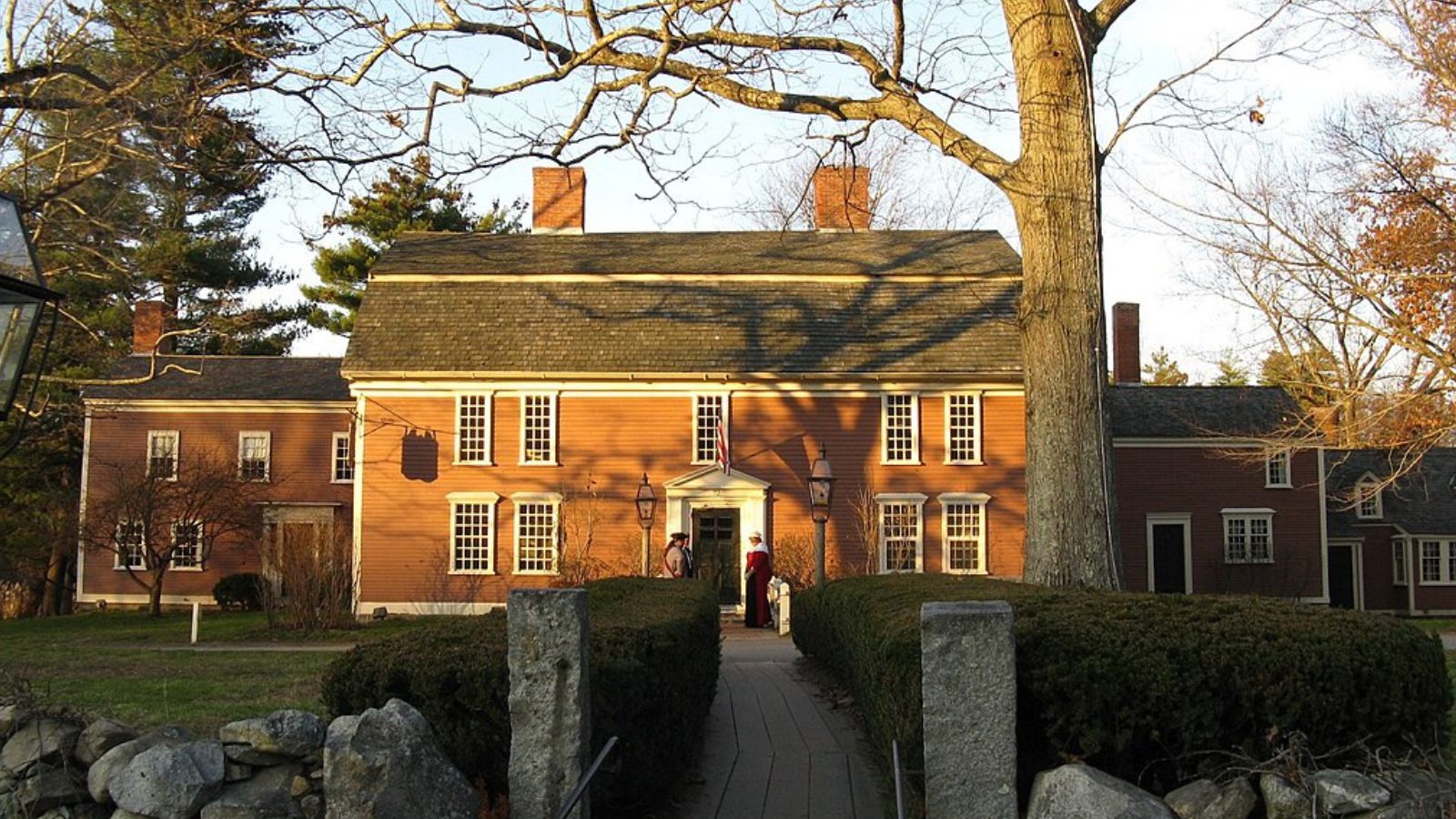
Why Are People Willing to Pay So Much to Live Here? What’s Special About It?
Sudbury attracts families seeking top-tier education in the highly regarded Lincoln-Sudbury Regional High School district. The town maintains a rural character with conservation land, historic sites, and agricultural areas while providing easy access to Route 20 and the Mass Pike. Residents appreciate the balance between small-town atmosphere and proximity to Boston’s employment centers.
How Sudbury Rose to Prominence
Incorporated in 1639, Sudbury was one of the first inland settlements west of Boston, established along the Sudbury River. The town gained historical significance as the birthplace of the American colonial militia movement and later became a center for agriculture and light industry. Modern development began in earnest after World War II when improved highways made it accessible to Boston commuters seeking suburban living.
3 Interesting Tidbits
1. Revolutionary War Site: The Old North Bridge area in Sudbury played a crucial role in the events leading to the Revolutionary War battles at nearby Lexington and Concord.
2. Wayside Inn: Longfellow’s Wayside Inn, made famous by Henry Wadsworth Longfellow’s poem, operates as both a historic site and working inn in Sudbury.
3. Great Meadows: The town contains part of the Great Meadows National Wildlife Refuge, providing habitat for waterfowl and offering residents access to pristine natural areas.
27. Wayland – 122% Home Price Increase Since 2010

- 2010: $530,259
- 2011: $514,826
- 2012: $535,178
- 2013: $568,349
- 2014: $645,911
- 2015: $674,795
- 2016: $701,585
- 2017: $719,730
- 2018: $759,128
- 2019: $766,452
- 2020: $788,188
- 2021: $899,415
- 2022: $1,035,607
- 2023: $1,066,383
- 2024: $1,159,941
- 2025: $1,174,718
Wayland has more than doubled in value since 2010, showing one of the strongest appreciation rates on this list at 122%. The town crossed the million-dollar threshold in 2022 and continues climbing toward $1.2 million. This consistent growth reflects sustained demand for Wayland’s combination of excellent schools, natural beauty, and convenient location.
Why Wayland?
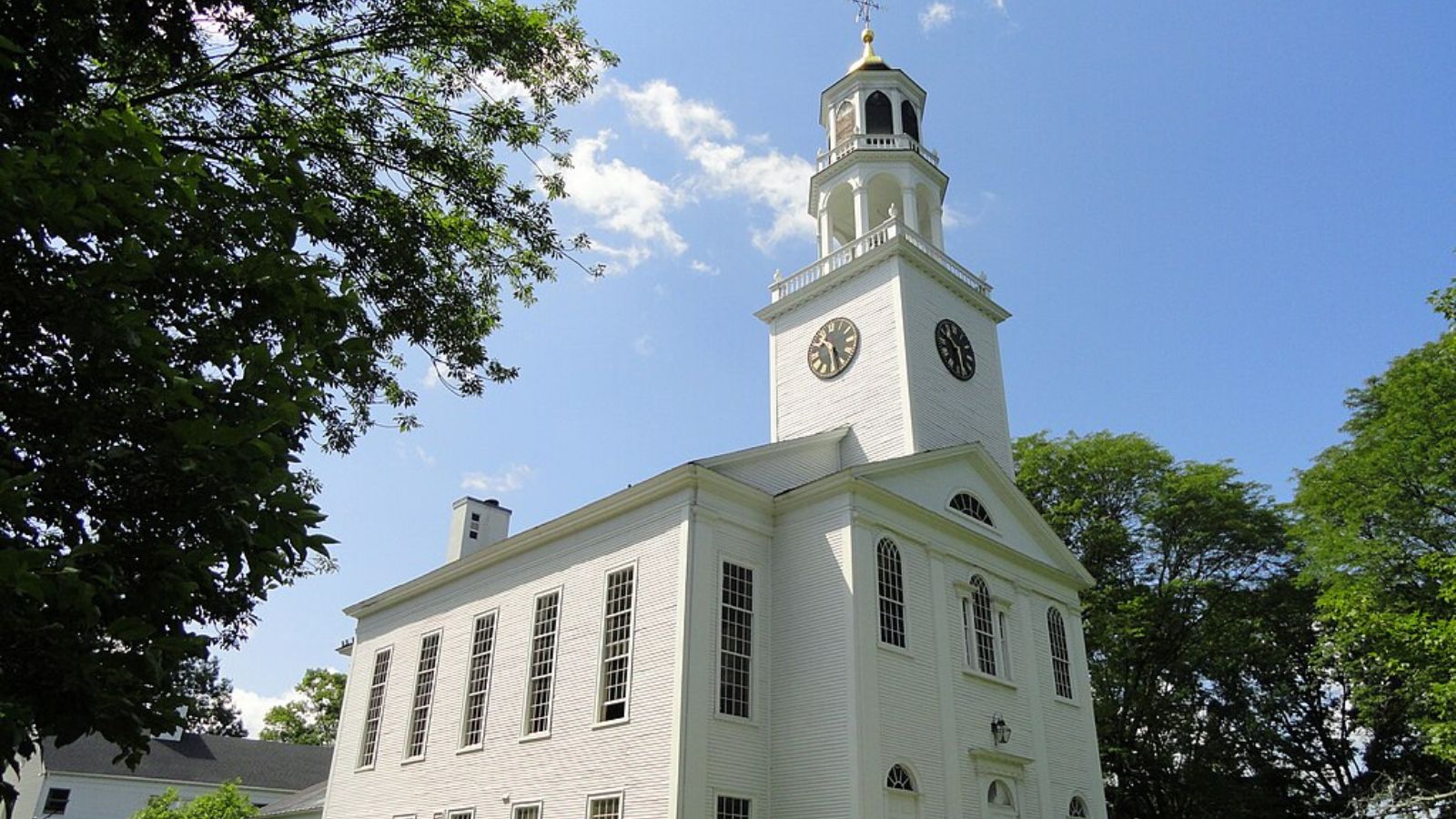
Why Are People Willing to Pay So Much to Live Here? What’s Special About It?
Families are drawn to Wayland’s exceptional public school system and abundant recreational opportunities including multiple lakes and conservation areas. The town offers a perfect balance of suburban amenities and rural character, with walking trails, parks, and preserved open spaces. Professional families appreciate the direct rail access to Boston via the MBTA Framingham/Worcester line and proximity to major employment centers.
How Wayland Rose to Prominence
Settled in 1638 and incorporated in 1780, Wayland was named after Francis Wayland, a prominent Baptist minister and educator. The town developed around agriculture and later light manufacturing, with the arrival of the railroad in the 1850s connecting it more closely to Boston. Post-war suburban expansion transformed Wayland into a desirable residential community while preserving much of its historic character and natural landscape.
3 Interesting Tidbits
1. Lake Cochituate: This 625-acre lake was Boston’s primary water supply from 1848 to 1951 and now serves as a popular recreational area for swimming, boating, and fishing.
2. Wayland Town Beach: The town maintains several public beaches on its various ponds and lakes, providing residents with freshwater recreation opportunities.
3. Historic Train Depot: The restored 1881 train depot now serves as a community center and symbol of Wayland’s connection to Boston’s development.
26. Brookline – 89% Home Price Increase Since 2010
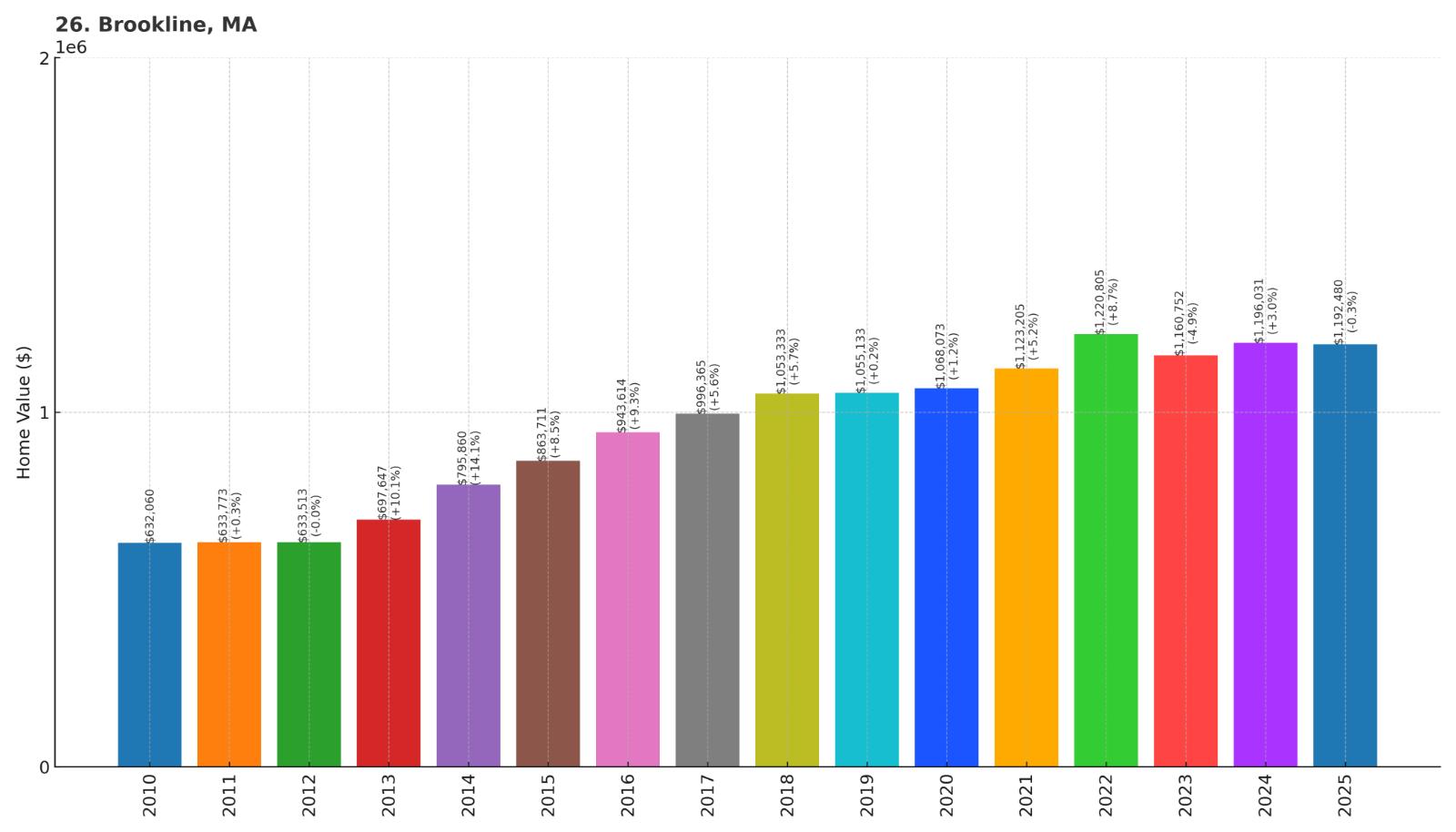
- 2010: $632,060
- 2011: $633,773
- 2012: $633,513
- 2013: $697,647
- 2014: $795,860
- 2015: $863,711
- 2016: $943,614
- 2017: $996,365
- 2018: $1,053,333
- 2019: $1,055,133
- 2020: $1,068,073
- 2021: $1,123,205
- 2022: $1,220,805
- 2023: $1,160,752
- 2024: $1,196,031
- 2025: $1,192,480
Brookline has seen steady growth with values nearly doubling since 2010, reaching $1.19 million by 2025. The town crossed the million-dollar mark in 2018 and has remained above that threshold despite some fluctuation in recent years. This inner suburb benefits from its urban location while maintaining distinct neighborhood character.
Why Brookline?
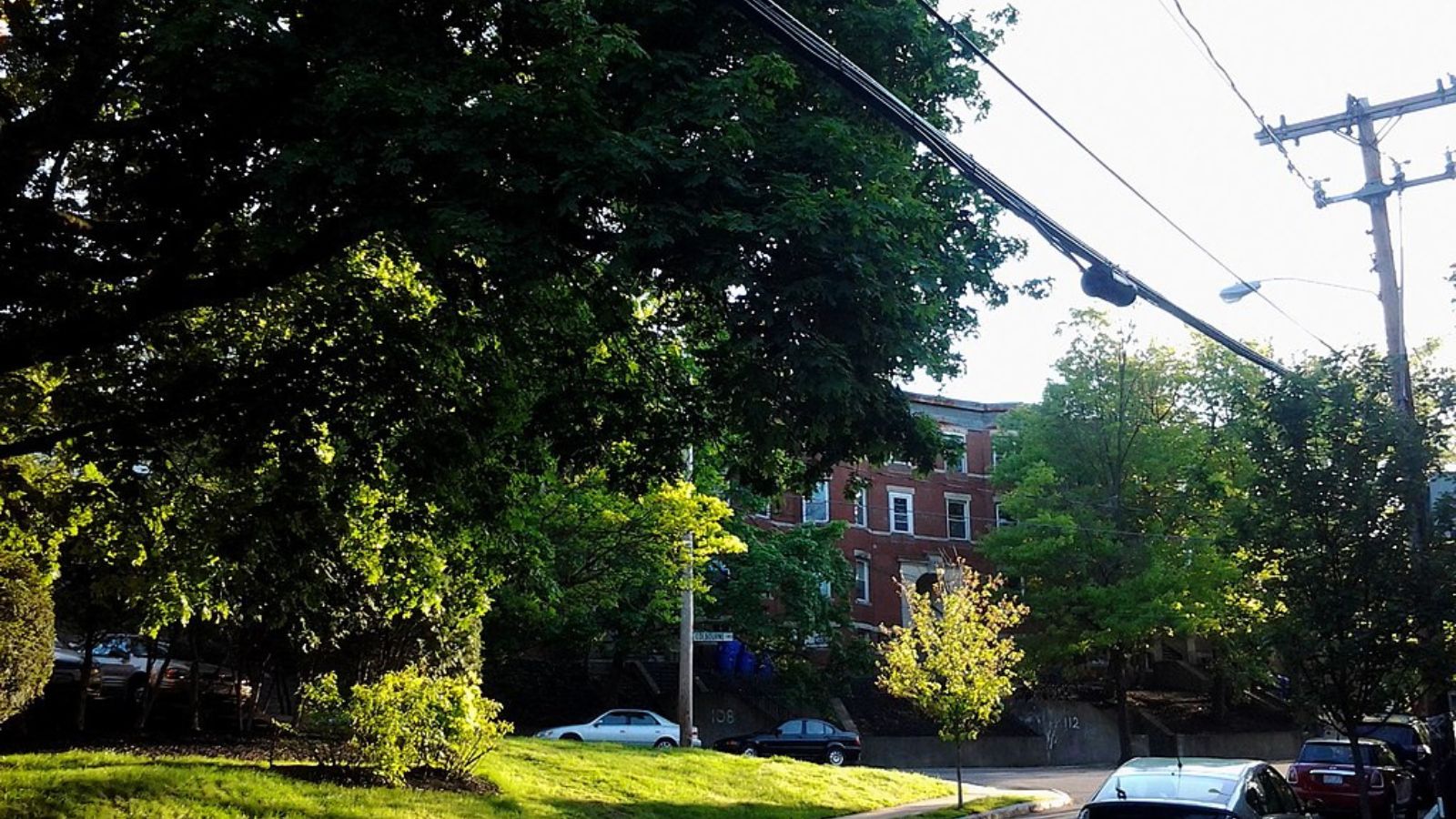
Why Are People Willing to Pay So Much to Live Here? What’s Special About It?
Brookline offers the best of both worlds: urban amenities with suburban feel, directly adjacent to Boston. Residents have access to excellent public transportation, world-class dining and shopping, plus highly rated schools. The town’s walkable neighborhoods, parks, and proximity to major employment centers make it particularly attractive to professionals and families who want city convenience without sacrificing quality of life.
How Brookline Rose to Prominence
Originally part of Boston, Brookline became an independent town in 1705 when residents sought local self-governance. The community developed as a streetcar suburb in the late 1800s, with grand homes built for Boston’s wealthy families seeking refuge from city congestion. The opening of the subway system in the early 1900s cemented Brookline’s status as a premium residential area with unmatched access to downtown Boston.
3 Interesting Tidbits
1. JFK Birthplace: President John F. Kennedy was born at 83 Beals Street in Brookline, and the house is now a National Historic Site.
2. Fenway Park Border: Part of famous Fenway Park actually sits in Brookline, making residents neighbors to the Boston Red Sox.
3. Country Club Legacy: The Country Club in Brookline is one of the oldest golf clubs in America and hosted the first U.S. Open golf championship in 1913.
25. Oak Bluffs – 159% Home Price Increase Since 2010
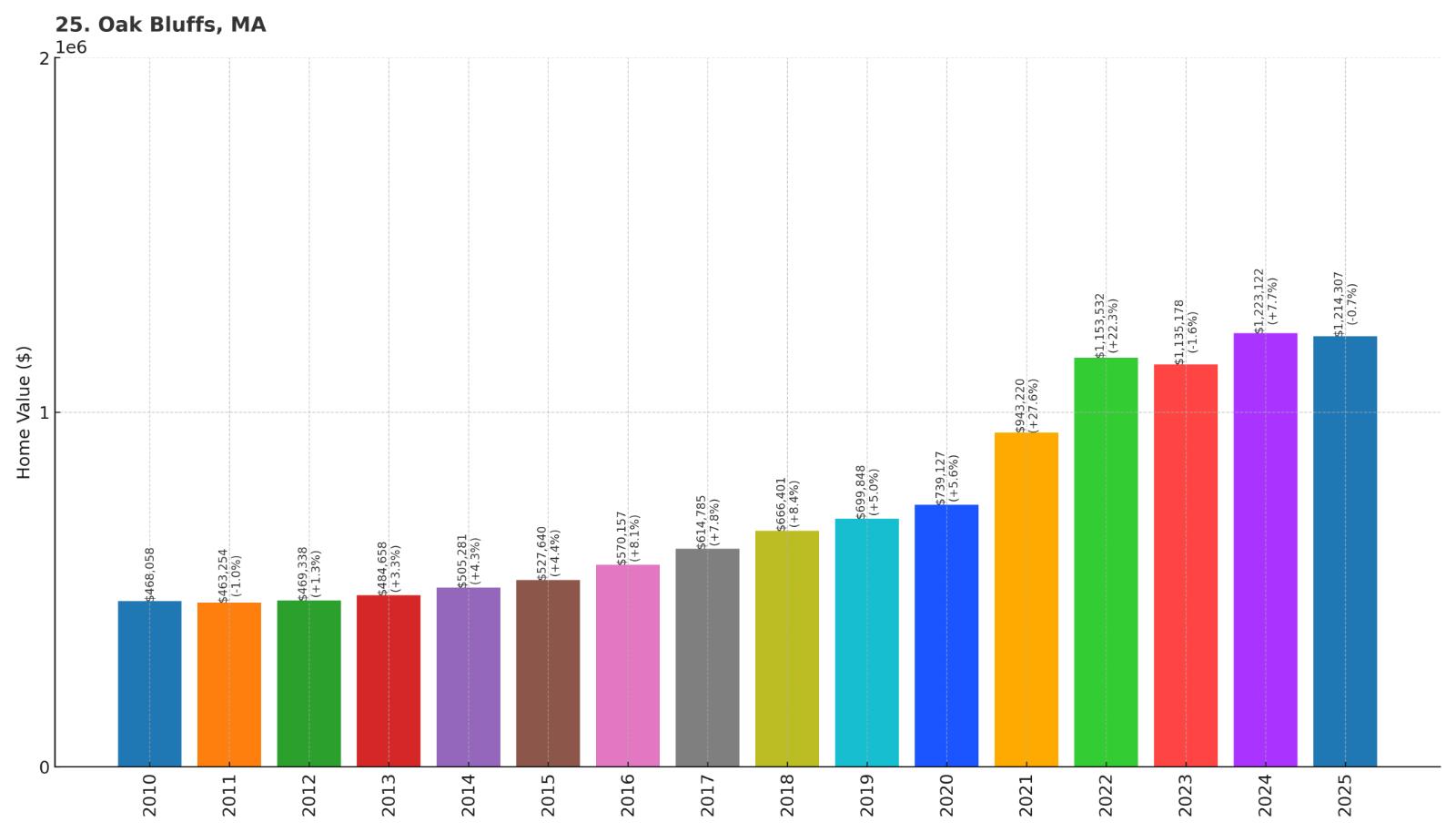
- 2010: $468,058
- 2011: $463,254
- 2012: $469,338
- 2013: $484,658
- 2014: $505,281
- 2015: $527,640
- 2016: $570,157
- 2017: $614,785
- 2018: $666,401
- 2019: $699,848
- 2020: $739,127
- 2021: $943,220
- 2022: $1,153,532
- 2023: $1,135,178
- 2024: $1,223,122
- 2025: $1,214,307
Oak Bluffs has seen the most dramatic price appreciation on Martha’s Vineyard, with values increasing 159% since 2010. The island community experienced explosive growth during the pandemic years, jumping from $739,000 in 2020 to over $1.1 million by 2022. This colorful resort town continues to command premium prices for its unique Victorian character and beachfront location.
Why Oak Bluffs?

Why Are People Willing to Pay So Much to Live Here? What’s Special About It?
Oak Bluffs offers a unique blend of Victorian charm, pristine beaches, and vibrant summer community life. The town’s famous “gingerbread cottages” and historic tabernacle create an atmosphere unlike anywhere else in New England. Buyers are drawn to the island lifestyle, excellent sailing and fishing opportunities, and the prestige of owning property in one of America’s most exclusive summer destinations.
How Oak Bluffs Rose to Prominence
Oak Bluffs began as a Methodist camp meeting ground in the 1830s, with families building elaborate Victorian cottages around the central tabernacle. The arrival of steamboat service in the mid-1800s transformed it into a popular resort destination for wealthy Boston families. The town became famous for its inclusive community, welcoming diverse visitors when many other resort areas were segregated, establishing Oak Bluffs as a unique and progressive summer retreat.
3 Interesting Tidbits
1. Gingerbread Cottages: Oak Bluffs is home to over 300 ornate Victorian cottages built in the Methodist camp meeting style, creating one of America’s most photographed neighborhoods.
2. Flying Horses Carousel: The nation’s oldest platform carousel, built in 1876, still operates on Circuit Avenue and is a National Historic Landmark.
3. Inkwell Beach: This popular Oak Bluffs beach became known as “The Inkwell” and has been a gathering place for prominent African American families for over a century.
24. Sherborn – 81% Home Price Increase Since 2010
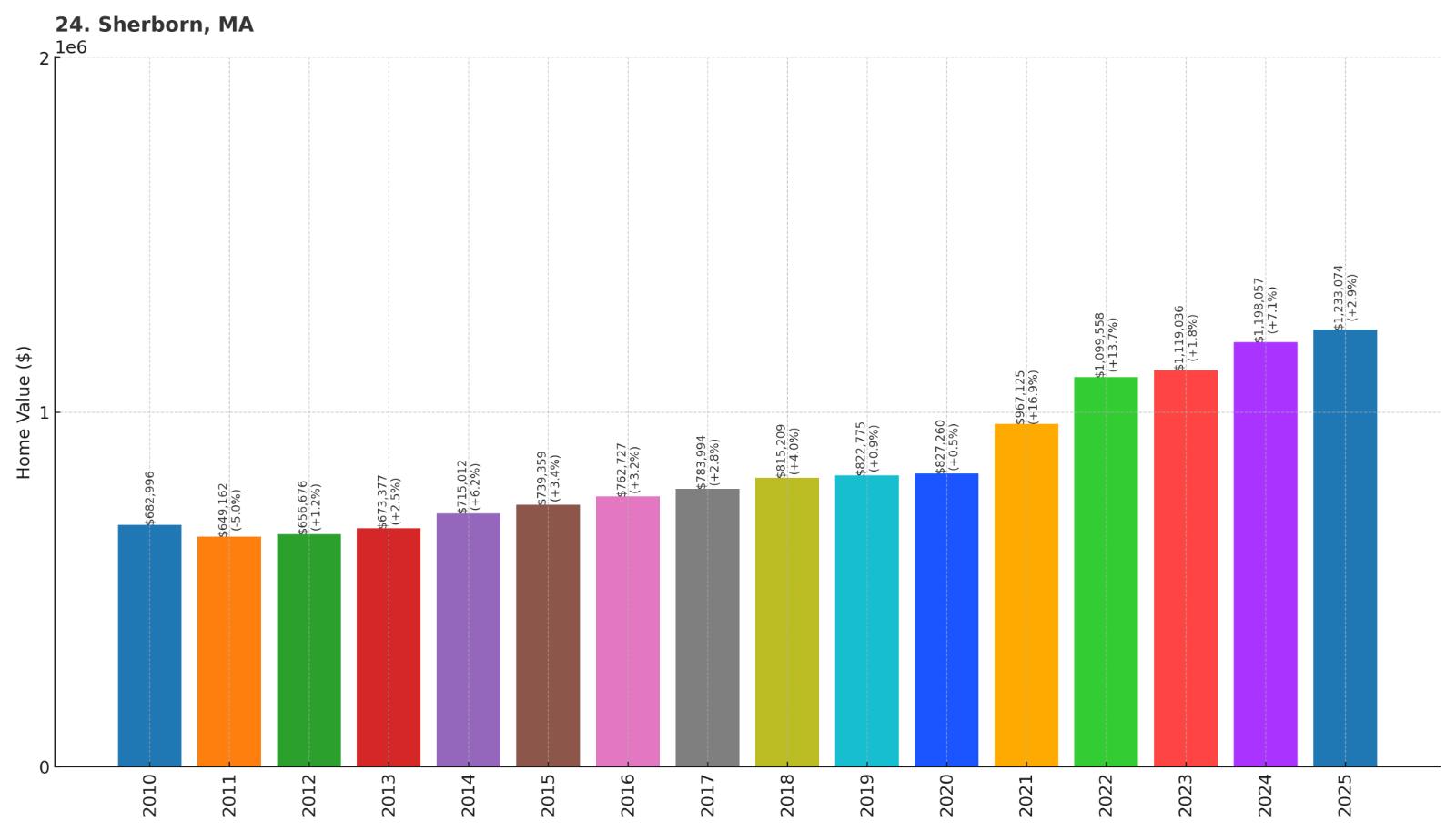
- 2010: $682,996
- 2011: $649,162
- 2012: $656,676
- 2013: $673,377
- 2014: $715,012
- 2015: $739,359
- 2016: $762,727
- 2017: $783,994
- 2018: $815,209
- 2019: $822,775
- 2020: $827,260
- 2021: $967,125
- 2022: $1,099,558
- 2023: $1,119,036
- 2024: $1,198,057
- 2025: $1,233,074
Sherborn has grown steadily since 2010, with home values increasing 81% to reach $1.23 million by 2025. The town showed particular strength during the pandemic years, jumping from $827,000 in 2020 to nearly $1.1 million by 2022. This rural MetroWest community maintains its agricultural character while serving as a premium residential enclave.
Why Sherborn?
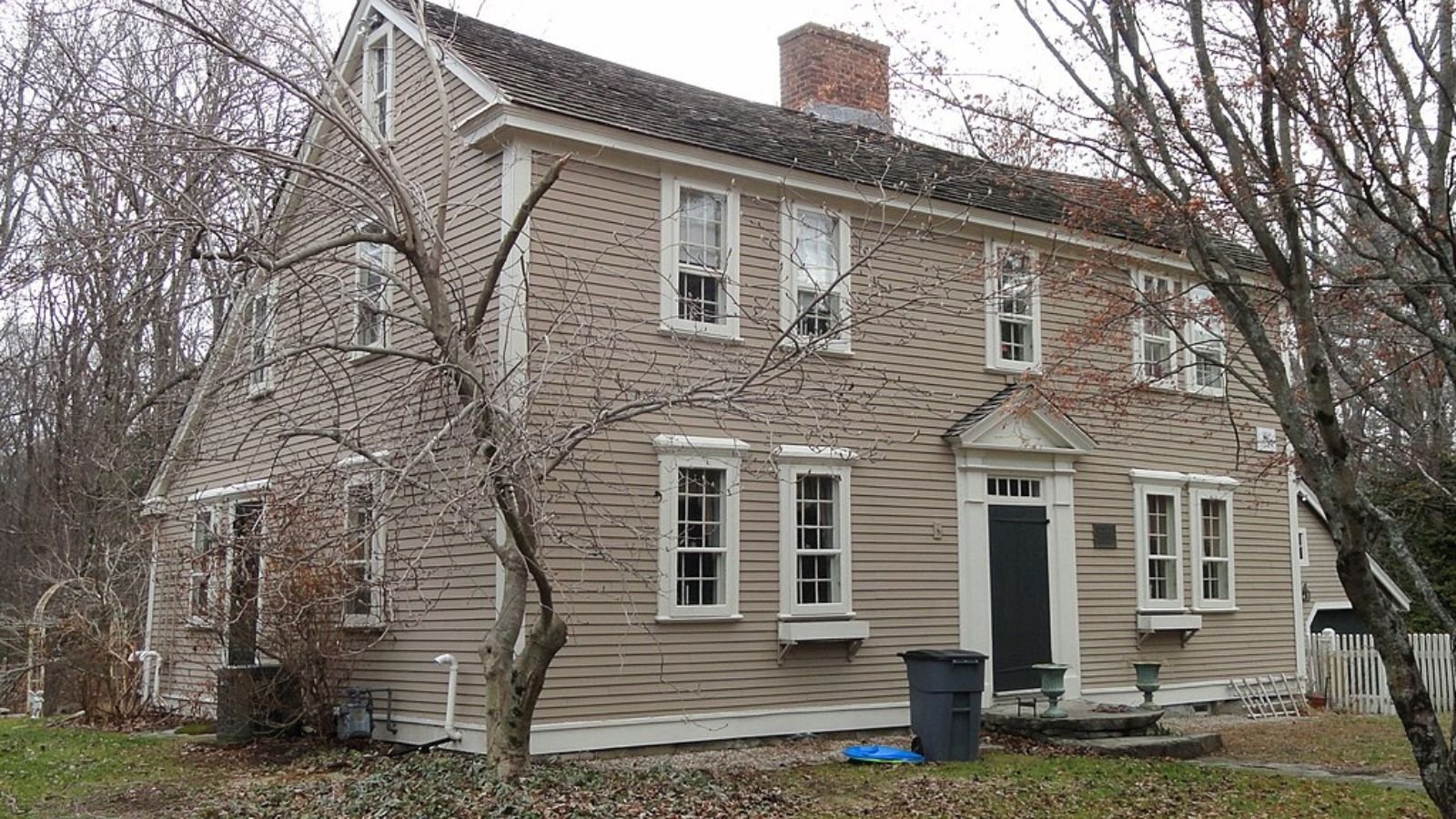
Why Are People Willing to Pay So Much to Live Here? What’s Special About It?
Sherborn offers families large lots, rural atmosphere, and top-tier schools in a location that’s still accessible to Boston. The town has preserved much of its historic character with horse farms, conservation land, and colonial architecture. Residents value the strong sense of community, excellent public services, and the ability to enjoy country living while maintaining professional careers in the city.
How Sherborn Rose to Prominence
Incorporated in 1674, Sherborn began as an agricultural community with farms and mills along the Charles River. The town remained largely rural through the 20th century, resisting suburban development in favor of preserving open space and historic character. This commitment to controlled growth and environmental protection has made Sherborn increasingly desirable for families seeking an authentic New England town experience within commuting distance of Boston.
3 Interesting Tidbits
1. Rocky Narrows: This 227-acre reservation along the Charles River offers hiking trails and scenic overlooks popular with residents and visitors.
2. Heritage of Pride: Sherborn has maintained a proud agricultural heritage with working farms and equestrian facilities still operating throughout the town.
3. Town Forest: Sherborn manages over 1,800 acres of conservation and town forest land, preserving rural character for future generations.
23. Westwood – 112% Home Price Increase Since 2010
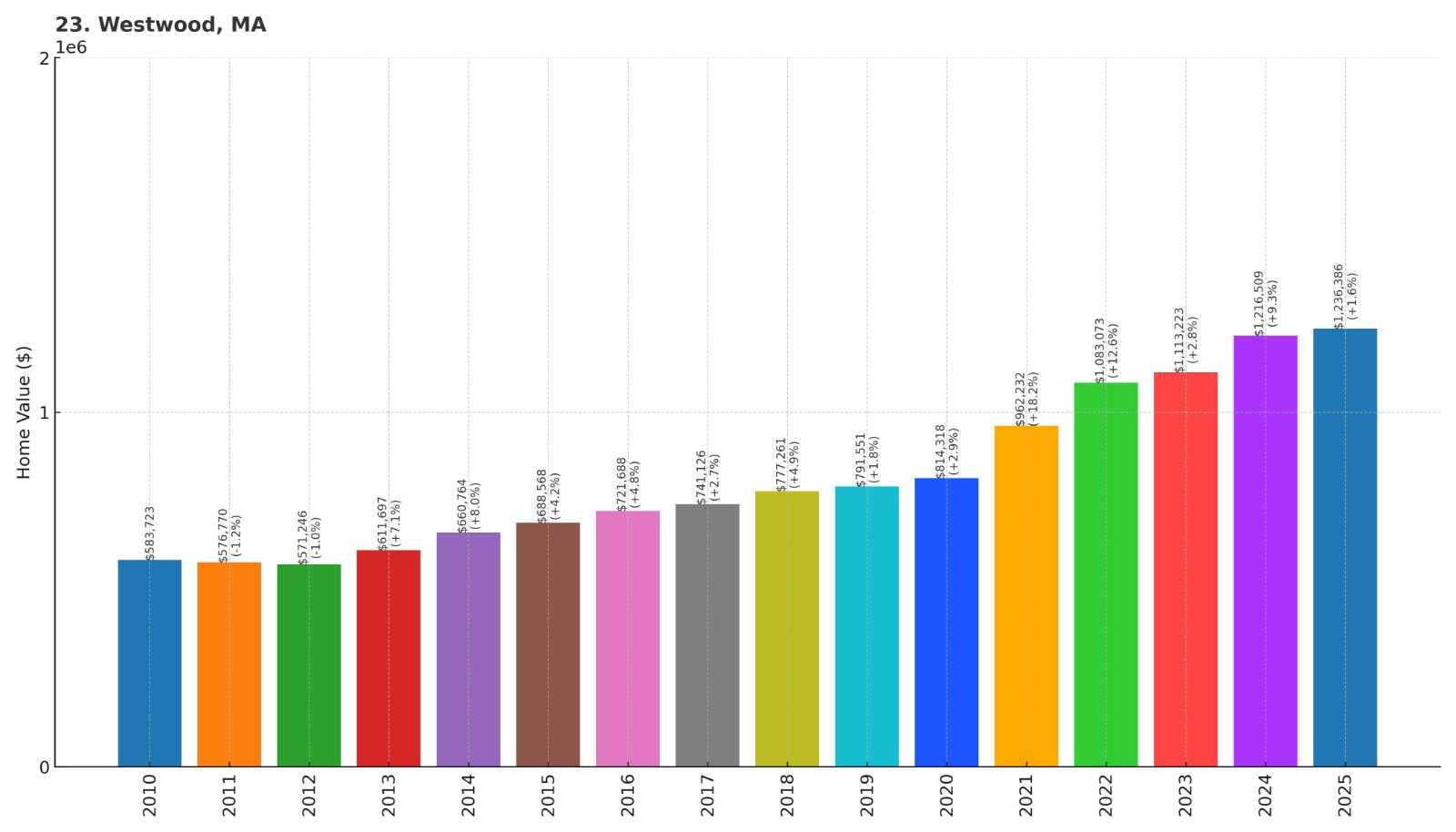
- 2010: $583,723
- 2011: $576,770
- 2012: $571,246
- 2013: $611,697
- 2014: $660,764
- 2015: $688,568
- 2016: $721,688
- 2017: $741,126
- 2018: $777,261
- 2019: $791,551
- 2020: $814,318
- 2021: $962,232
- 2022: $1,083,073
- 2023: $1,113,223
- 2024: $1,216,509
- 2025: $1,236,386
Westwood has more than doubled in value since 2010, showing strong 112% appreciation to reach $1.24 million by 2025. The town experienced significant acceleration in 2021-2022, crossing the million-dollar threshold and continuing to climb. This South Shore community benefits from excellent schools and convenient access to both Boston and Route 95 employment corridors.
Why Westwood?
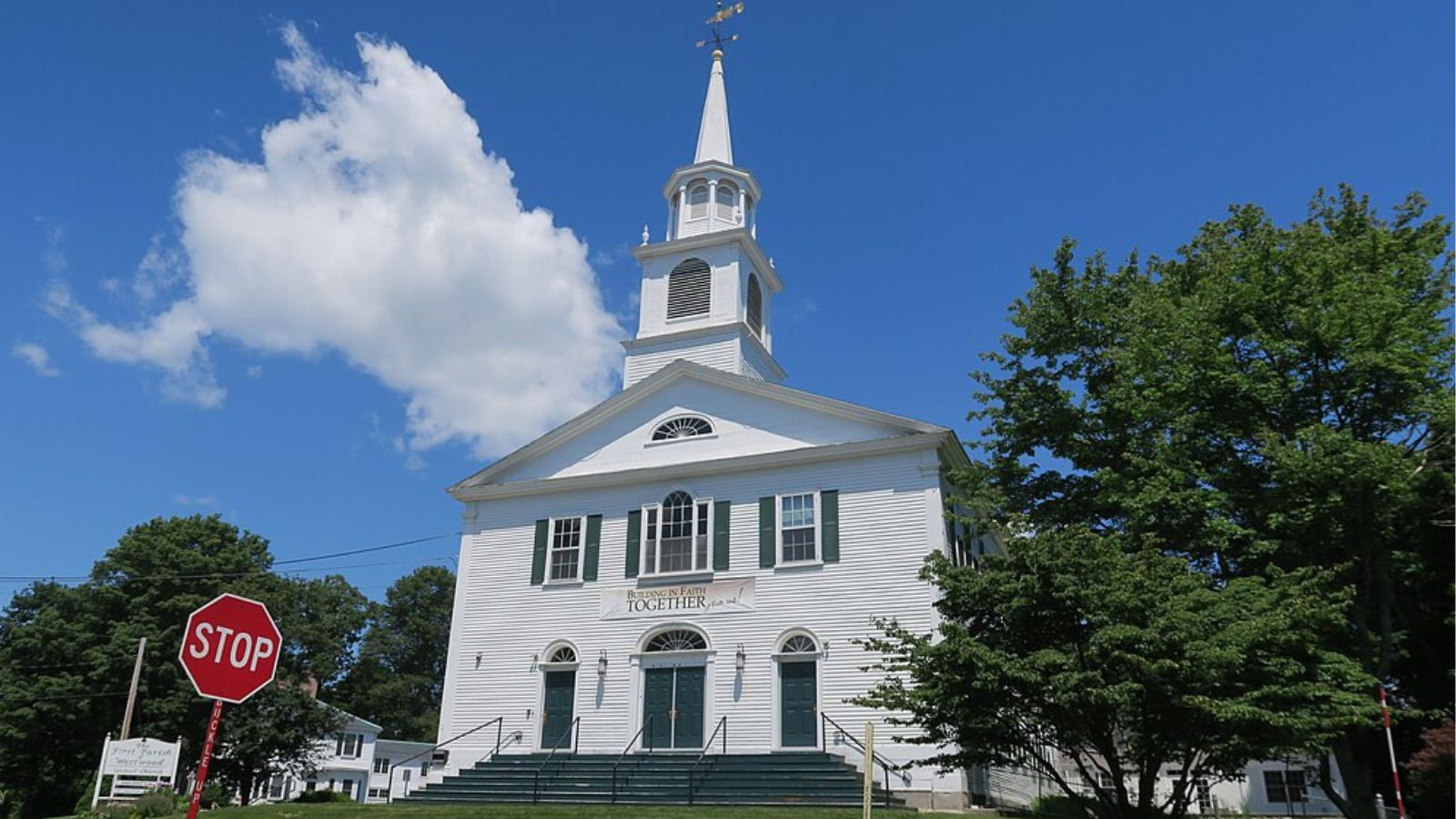
Why Are People Willing to Pay So Much to Live Here? What’s Special About It?
Westwood attracts families seeking excellent public schools, safe neighborhoods, and a strong sense of community. The town offers a perfect suburban environment with well-maintained parks, recreational facilities, and local businesses that create a true town center atmosphere. Residents appreciate the convenient commuter rail access to Boston and proximity to major highways for those working throughout the metro area.
How Westwood Rose to Prominence
Originally part of Dedham, Westwood was incorporated as a separate town in 1897 when residents sought better local representation and services. The community developed around the railroad station, with residential neighborhoods growing up around the town center. The post-war suburban boom transformed Westwood into a sought-after family community while maintaining its small-town character and strong municipal services.
3 Interesting Tidbits
1. Westwood Station: The MBTA commuter rail station provides direct service to Boston’s Back Bay and South Station, making it highly attractive to city commuters.
2. Hale Reservation: This 1,100-acre reservation offers residents extensive hiking trails, educational programs, and outdoor recreation opportunities.
3. Legacy Place: The town is home to this popular outdoor shopping and dining destination that serves the entire South Shore region.
22. Gosnold – 69% Home Price Increase Since 2012
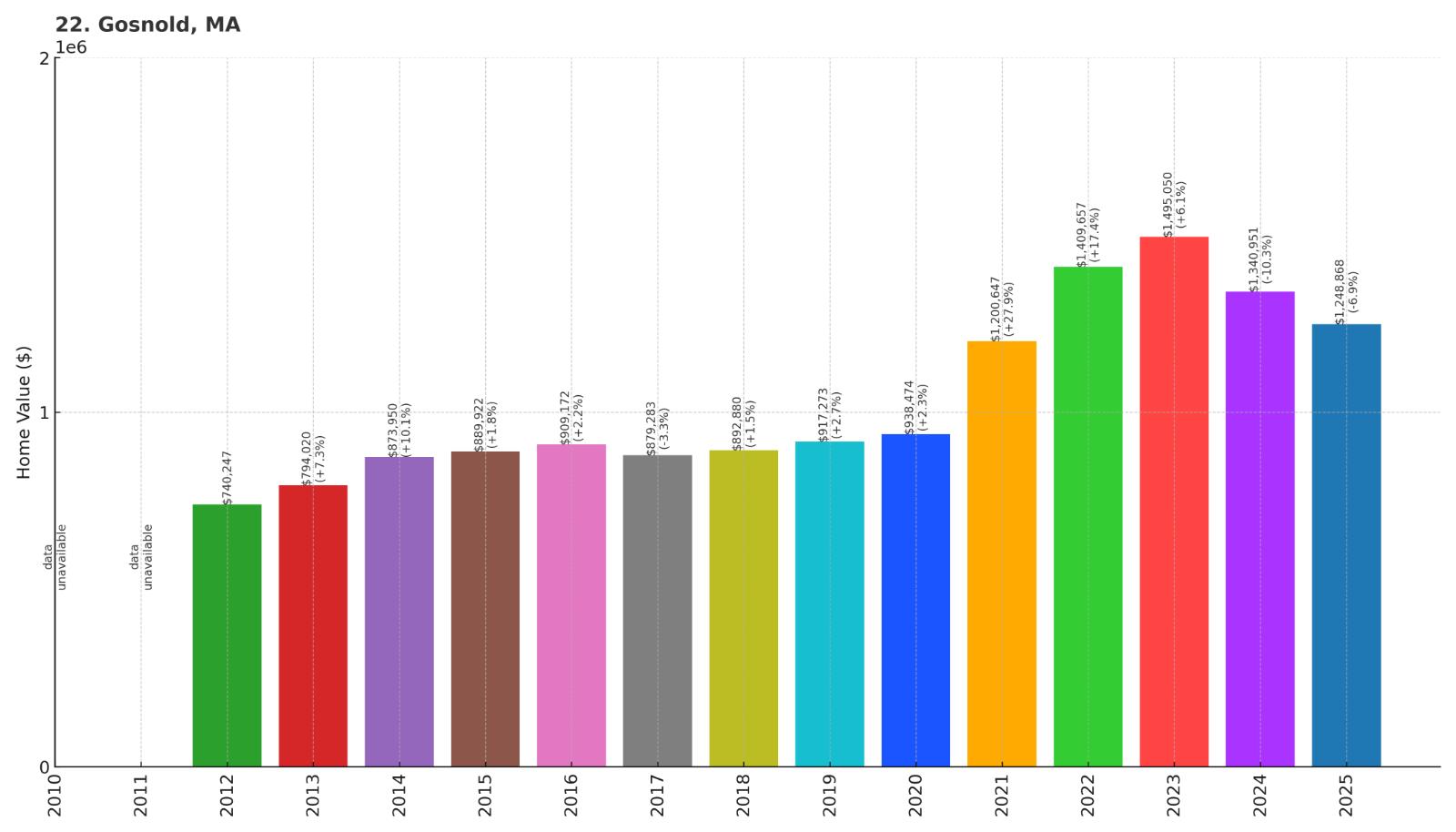
- 2010: N/A
- 2011: N/A
- 2012: $740,247
- 2013: $794,020
- 2014: $873,950
- 2015: $889,922
- 2016: $909,172
- 2017: $879,283
- 2018: $892,880
- 2019: $917,273
- 2020: $938,474
- 2021: $1,200,647
- 2022: $1,409,657
- 2023: $1,495,050
- 2024: $1,340,951
- 2025: $1,248,868
Gosnold has seen steady growth with a 69% increase since 2012, reaching $1.25 million by 2025. This tiny island community experienced dramatic volatility during the pandemic years, peaking at nearly $1.5 million in 2023 before moderating. With data only available from 2012 forward, Gosnold represents one of Massachusetts’ most exclusive and limited real estate markets.
Why Gosnold?

Why Are People Willing to Pay So Much to Live Here? What’s Special About It?
Gosnold offers the ultimate in privacy and exclusivity, consisting primarily of the Elizabeth Islands including Cuttyhunk Island. Property ownership is extremely limited, creating intense scarcity that drives premium pricing. Buyers are drawn to the unspoiled natural beauty, complete privacy, and the prestige of owning property in one of New England’s most remote and exclusive locations.
How Gosnold Rose to Prominence
Named after explorer Bartholomew Gosnold who landed here in 1602, this chain of islands remained largely undeveloped for centuries. The Forbes family purchased most of the Elizabeth Islands in the 1840s, creating private estates and limiting development. This history of private ownership and controlled access has made Gosnold one of the most exclusive residential areas in Massachusetts, where property rarely comes to market.
3 Interesting Tidbits
1. Forbes Family Legacy: The Forbes family has owned most of the Elizabeth Islands for over 180 years, maintaining them as a private retreat and conservation area.
2. Cuttyhunk Island: The only year-round inhabited island in Gosnold, with a population of fewer than 20 permanent residents.
3. Bartholomew Gosnold: The town is named after the English explorer who was among the first Europeans to land in New England and helped establish Jamestown, Virginia.
21. Chatham – 104% Home Price Increase Since 2010
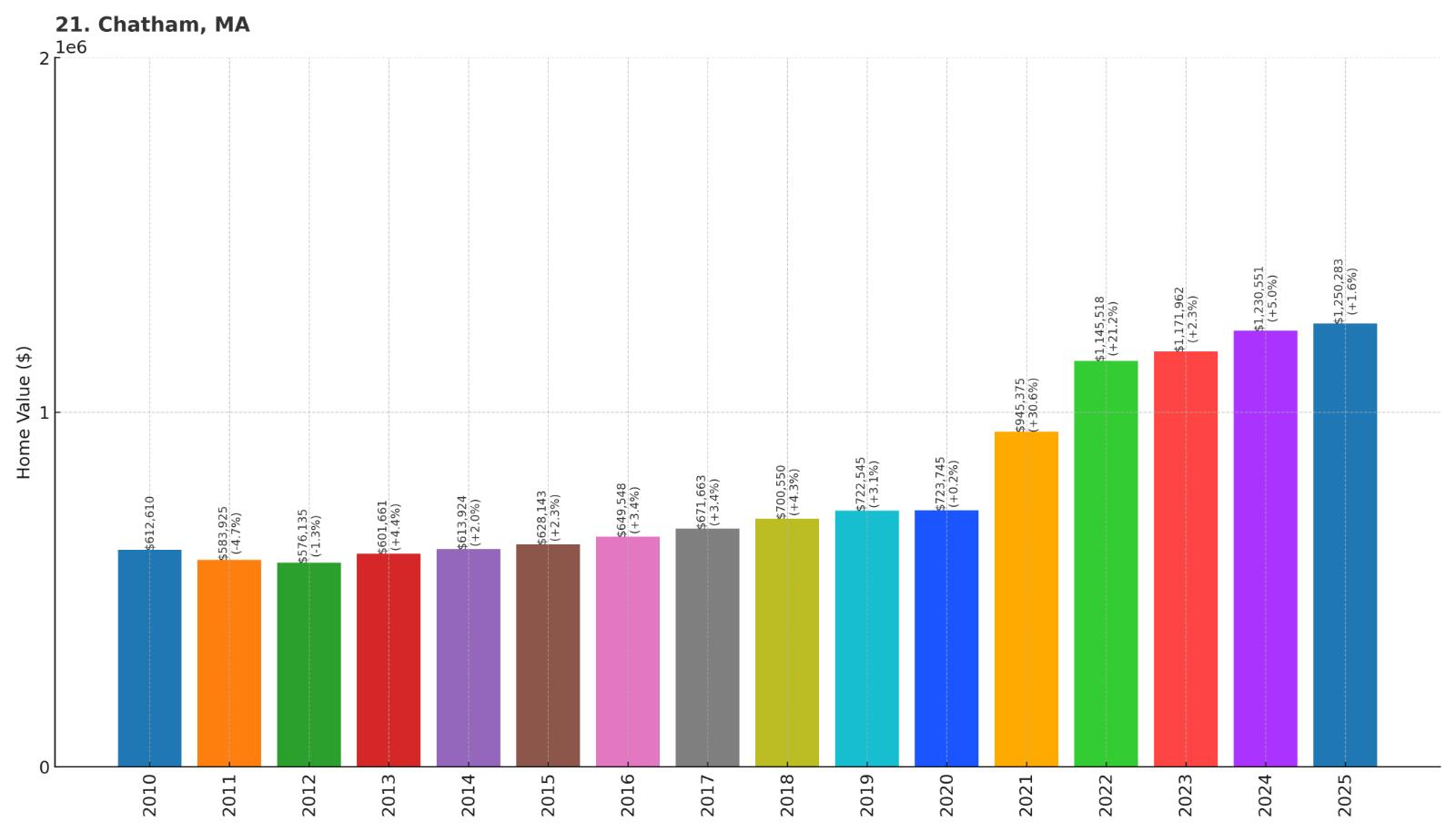
- 2010: $612,610
- 2011: $583,925
- 2012: $576,135
- 2013: $601,661
- 2014: $613,924
- 2015: $628,143
- 2016: $649,548
- 2017: $671,663
- 2018: $700,550
- 2019: $722,545
- 2020: $723,745
- 2021: $945,375
- 2022: $1,145,518
- 2023: $1,171,962
- 2024: $1,230,551
- 2025: $1,250,283
Chatham has exactly doubled in value since 2010, showing strong 104% appreciation to reach $1.25 million by 2025. This Cape Cod resort town experienced dramatic acceleration during the pandemic years, jumping from $723,000 in 2020 to over $945,000 by 2021. The town’s oceanfront location and resort amenities continue to drive premium pricing.
Why Chatham?

Why Are People Willing to Pay So Much to Live Here? What’s Special About It?
Chatham offers classic Cape Cod charm with pristine beaches, scenic harbors, and a picturesque downtown area. The town attracts buyers seeking waterfront living, excellent boating and fishing opportunities, and the prestige of owning property in one of the Cape’s most desirable locations. Families value the strong seasonal community, cultural amenities, and recreational activities that define the Cape Cod lifestyle.
How Chatham Rose to Prominence
Incorporated in 1712, Chatham developed as a fishing and maritime community at the “elbow” of Cape Cod. The town’s strategic location made it important for shipping and later for tourism as wealthy families discovered its scenic beauty in the late 1800s. The development of summer cottages and resort amenities established Chatham as a premier Cape Cod destination, attracting visitors and second-home owners who eventually drive up property values.
3 Interesting Tidbits
1. Chatham Light: The town’s iconic lighthouse, built in 1808, serves as both a working navigational aid and one of Cape Cod’s most photographed landmarks.
2. Fish Pier: Chatham’s working fish pier remains one of the few active commercial fishing operations on Cape Cod, maintaining the town’s maritime heritage.
3. Monomoy Island: This barrier island off Chatham serves as a National Wildlife Refuge and important stopover for migrating birds and marine life.
20. Tisbury – 140% Home Price Increase Since 2010
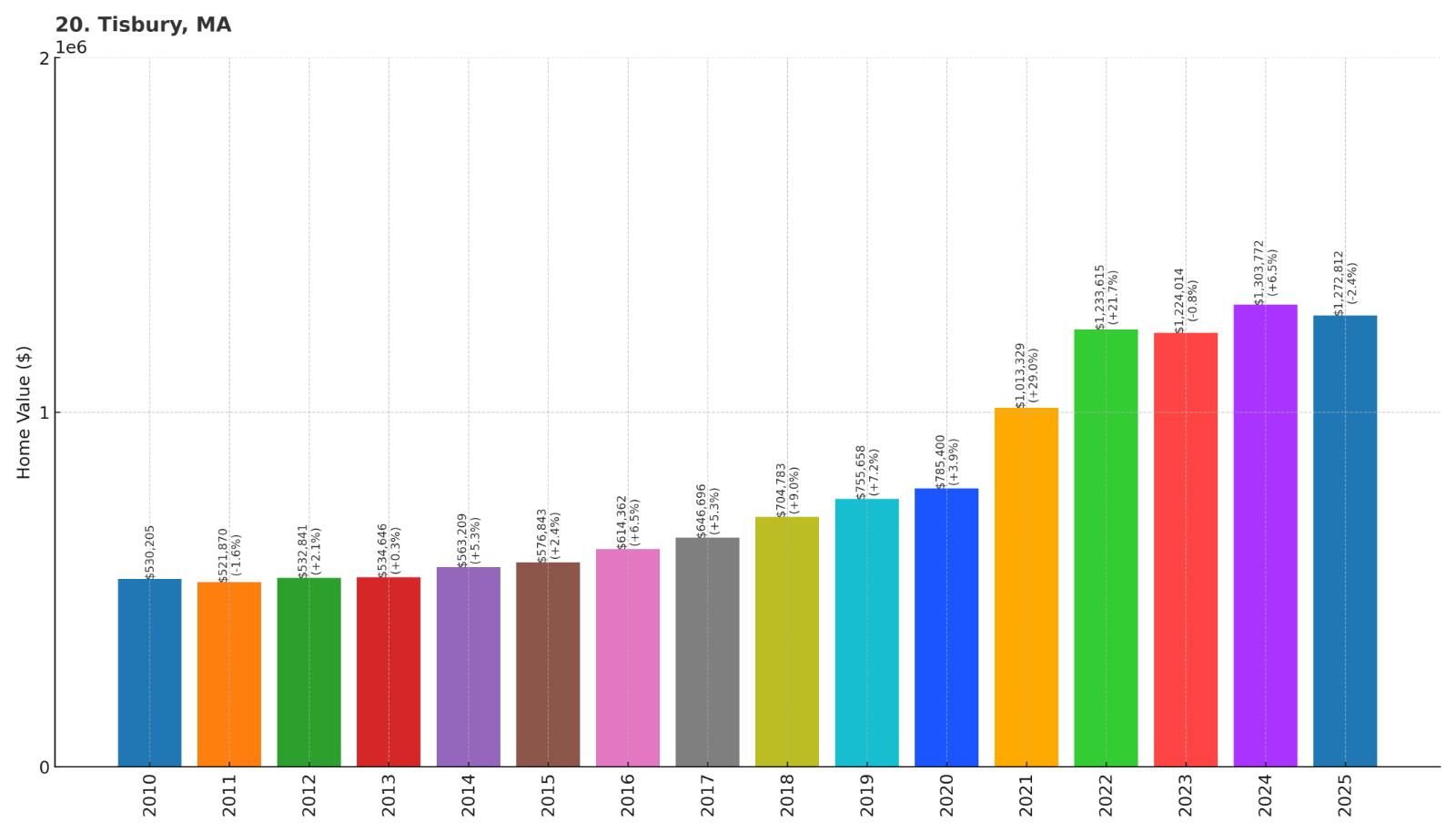
- 2010: $530,205
- 2011: $521,870
- 2012: $532,841
- 2013: $534,646
- 2014: $563,209
- 2015: $576,843
- 2016: $614,362
- 2017: $646,696
- 2018: $704,783
- 2019: $755,658
- 2020: $785,400
- 2021: $1,013,329
- 2022: $1,233,615
- 2023: $1,224,014
- 2024: $1,303,772
- 2025: $1,272,812
Tisbury has shown exceptional growth with a 140% increase since 2010, reaching $1.27 million by 2025. This Martha’s Vineyard town experienced explosive growth during the pandemic, jumping from $785,000 in 2020 to over $1 million by 2021. Home to Vineyard Haven, Tisbury serves as the island’s main port and commercial center while maintaining premium residential pricing.
Why Tisbury?

Why Are People Willing to Pay So Much to Live Here? What’s Special About It?
Tisbury combines the convenience of being Martha’s Vineyard’s main port town with the exclusivity of island living. Vineyard Haven offers year-round amenities, ferry access, and a vibrant downtown area while maintaining the island’s characteristic charm. Buyers are attracted to the deep-water harbor, historic architecture, and the prestige of Martha’s Vineyard ownership without sacrificing convenience.
How Tisbury Rose to Prominence
Originally called Holmes Hole after early settler John Holmes, Tisbury was renamed in 1871 to avoid confusion with a similarly named town. The community developed as Martha’s Vineyard’s primary port, serving whaling ships and later steamboat passengers from the mainland. Vineyard Haven’s protected harbor and year-round ferry service made it the island’s commercial center, while the surrounding areas developed into prestigious residential neighborhoods.
3 Interesting Tidbits
1. West Chop Lighthouse: This 1838 lighthouse marks the entrance to Vineyard Haven harbor and is one of Martha’s Vineyard’s most recognizable landmarks.
2. Vineyard Playhouse: This professional theater company has been entertaining islanders and visitors for decades, contributing to the community’s cultural richness.
3. Black Dog Tavern: This famous restaurant and retail brand originated in Vineyard Haven and has become synonymous with Martha’s Vineyard culture worldwide.
19. Hingham – 109% Home Price Increase Since 2010
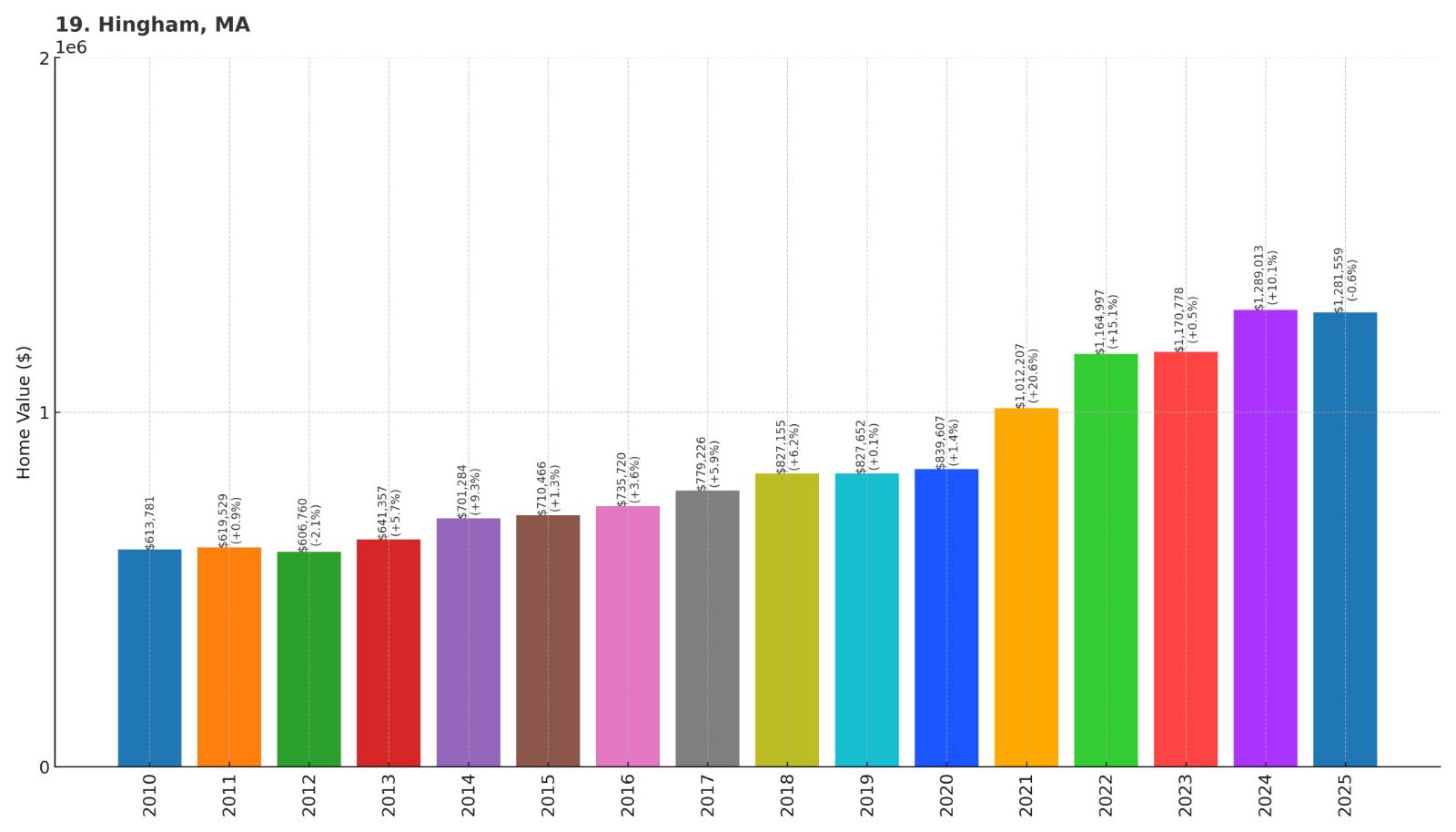
- 2010: $613,781
- 2011: $619,529
- 2012: $606,760
- 2013: $641,357
- 2014: $701,284
- 2015: $710,466
- 2016: $735,720
- 2017: $779,226
- 2018: $827,155
- 2019: $827,652
- 2020: $839,607
- 2021: $1,012,207
- 2022: $1,164,997
- 2023: $1,170,778
- 2024: $1,289,013
- 2025: $1,281,559
Hingham has more than doubled since 2010, showing strong 109% appreciation to reach $1.28 million by 2025. This South Shore town crossed the million-dollar threshold in 2021 and continues to show strength despite some recent moderation. Hingham’s combination of coastal location, historic character, and excellent schools drives consistent buyer demand.
Why Hingham?
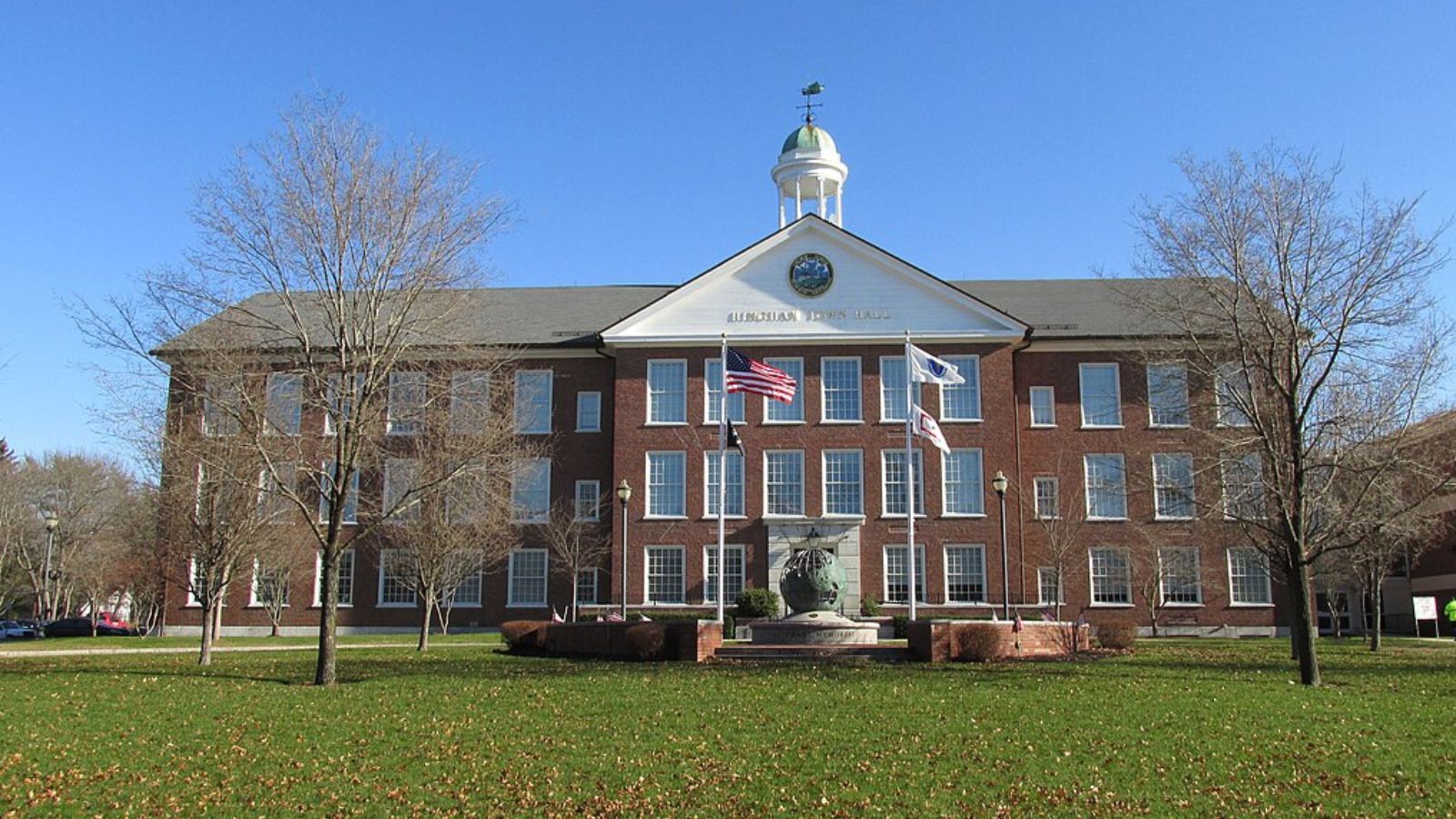
Why Are People Willing to Pay So Much to Live Here? What’s Special About It?
Hingham offers families an ideal combination of coastal living, top-rated schools, and historic New England charm. The town features beautiful harbors, conservation areas, and well-preserved colonial architecture alongside modern amenities. Residents value the strong sense of community, excellent public services, and ferry access to Boston that makes it attractive to professionals seeking suburban living with urban accessibility.
How Hingham Rose to Prominence
Settled in 1635 by Puritan colonists from Hingham, England, this South Shore community developed around its natural harbor and agricultural lands. The town played an important role in early American history and later became a center for shipbuilding and maritime commerce. The arrival of railroad service in the 1800s connected Hingham more closely to Boston, beginning its transformation into a sought-after residential community that attracted wealthy families seeking country estates.
3 Interesting Tidbits
1. Old Ship Church: Built in 1681, this is the oldest church building in continuous use in the United States and a masterpiece of Puritan architecture.
2. Hingham Harbor: The town’s deep-water harbor provides ferry service to downtown Boston, making it unique among South Shore communities.
3. World’s End: This 251-acre reservation designed by Frederick Law Olmsted offers stunning harbor views and is one of the most beautiful parks on the South Shore.
18. Manchester – 110% Home Price Increase Since 2010
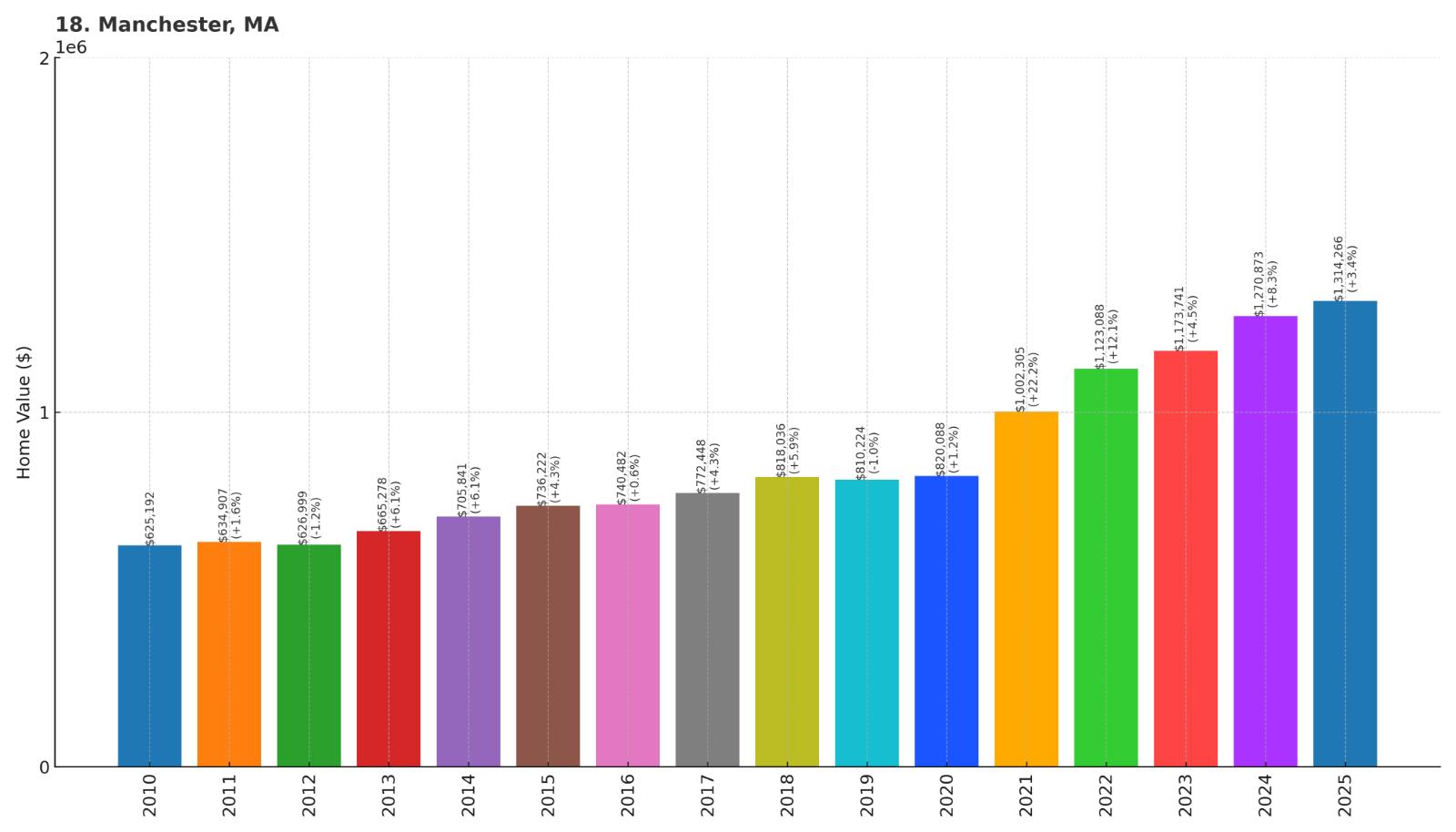
- 2010: $625,192
- 2011: $634,907
- 2012: $626,999
- 2013: $665,278
- 2014: $705,841
- 2015: $736,222
- 2016: $740,482
- 2017: $772,448
- 2018: $818,036
- 2019: $810,224
- 2020: $820,088
- 2021: $1,002,305
- 2022: $1,123,088
- 2023: $1,173,741
- 2024: $1,270,873
- 2025: $1,314,266
Manchester has more than doubled since 2010, showing 110% appreciation to reach $1.31 million by 2025. This North Shore coastal town crossed the million-dollar mark in 2021 and has continued climbing steadily. Manchester-by-the-Sea’s combination of oceanfront location, historic character, and proximity to Boston makes it one of the most desirable communities on the North Shore.
Why Manchester?
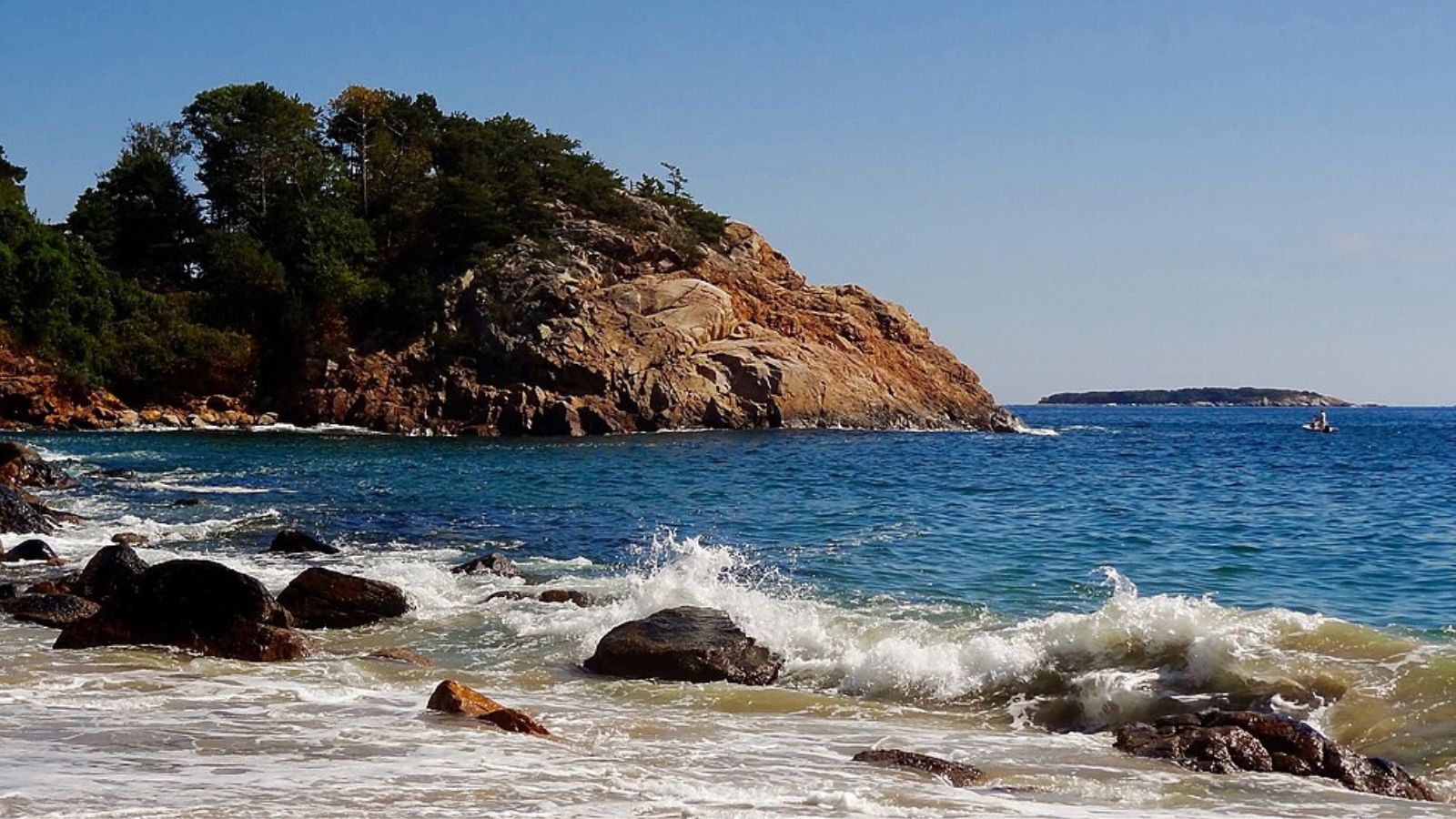
Why Are People Willing to Pay So Much to Live Here? What’s Special About It?
Manchester offers the perfect coastal New England lifestyle with rocky shores, pristine beaches, and elegant historic homes. The town attracts buyers seeking waterfront living, sailing opportunities, and a sophisticated summer resort atmosphere. Residents enjoy excellent schools, cultural amenities, and the prestige of living in one of the North Shore’s most exclusive communities while maintaining reasonable access to Boston.
How Manchester Rose to Prominence
Originally part of Salem, Manchester was incorporated as a separate town in 1645, taking its current name Manchester-by-the-Sea in 1989 to distinguish it from Manchester, New Hampshire. The community developed as both a fishing village and agricultural town until the late 1800s when wealthy Boston families discovered its scenic coastline and began building summer estates. This transformation established Manchester as a premier North Shore resort destination.
3 Interesting Tidbits
1. Singing Beach: This famous beach is named for the musical sound made by footsteps on its unique quartz sand composition.
2. Manchester Athletic Association: Founded in 1884, this private club features tennis courts and social facilities that have served the community for over a century.
3. Essex County Greenbelt: The organization was founded in Manchester in 1961 and has preserved thousands of acres of land throughout Essex County.
17. Carlisle – 81% Home Price Increase Since 2010
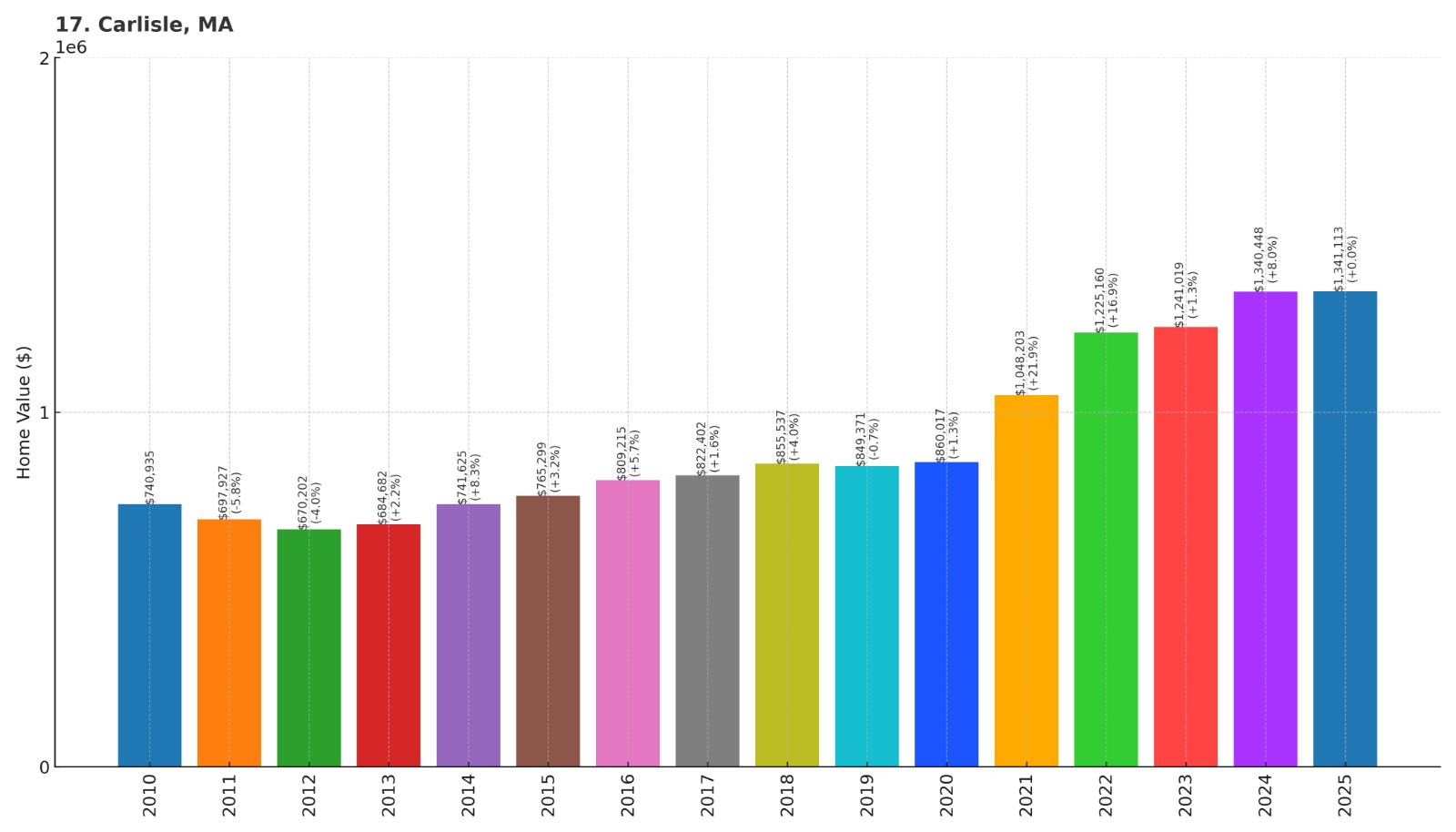
- 2010: $740,935
- 2011: $697,927
- 2012: $670,202
- 2013: $684,682
- 2014: $741,625
- 2015: $765,299
- 2016: $809,215
- 2017: $822,402
- 2018: $855,537
- 2019: $849,371
- 2020: $860,017
- 2021: $1,048,203
- 2022: $1,225,160
- 2023: $1,241,019
- 2024: $1,340,448
- 2025: $1,341,113
Carlisle has shown steady growth with an 81% increase since 2010, reaching $1.34 million by 2025. This rural MetroWest community experienced significant acceleration during the pandemic years, jumping from $860,000 in 2020 to over $1 million by 2021. Carlisle’s commitment to preserving rural character while providing access to Boston employment centers drives premium pricing.
Why Carlisle?

Why Are People Willing to Pay So Much to Live Here? What’s Special About It?
Carlisle offers families the opportunity to live in a rural setting with large lots, conservation land, and agricultural character while remaining accessible to Boston-area employment. The town has successfully preserved its historic landscape through careful zoning and land conservation efforts. Residents value the excellent schools, equestrian facilities, and small-town atmosphere that feels far removed from urban life despite being within commuting distance.
How Carlisle Rose to Prominence
Incorporated in 1780, Carlisle was carved out of parts of Acton, Billerica, Chelmsford, and Concord by residents seeking local representation. The community remained primarily agricultural for over two centuries, with farms, orchards, and rural estates defining its character. Modern development pressure led to innovative zoning laws and conservation efforts that preserved Carlisle’s rural nature while allowing controlled residential growth for affluent families seeking country living.
3 Interesting Tidbits
1. Great Brook Farm State Park: This 934-acre state park within Carlisle offers hiking trails, cross-country skiing, and a working dairy farm that produces ice cream.
2. Carlisle Public Schools: Despite its small size, Carlisle operates its own excellent elementary school before sending students to Concord-Carlisle Regional High School.
3. Rural Character Protection: Carlisle was one of the first Massachusetts communities to adopt large-lot zoning (2-acre minimum) to preserve its rural character and prevent overdevelopment.
16. Cohasset – 101% Home Price Increase Since 2010
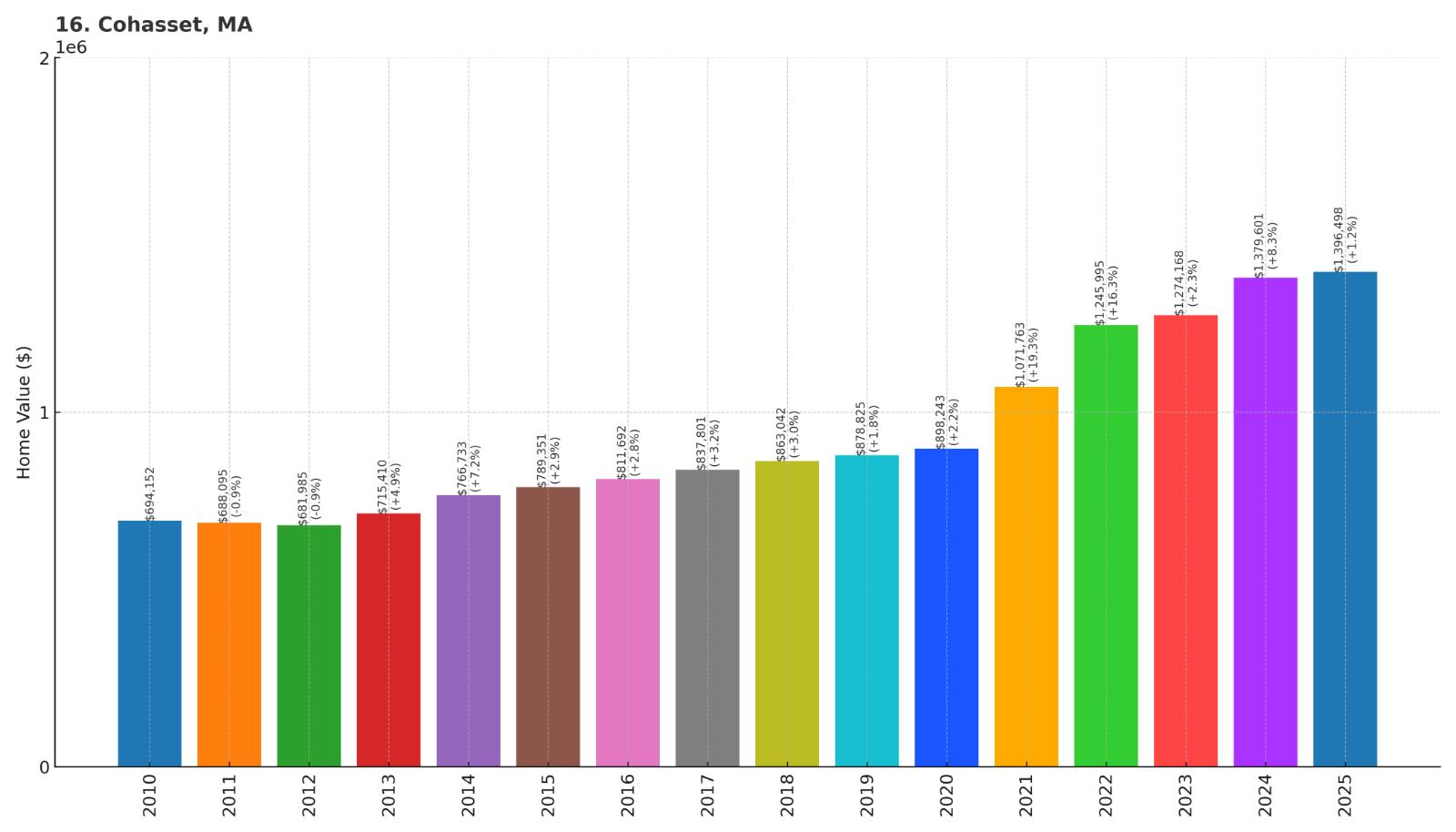
- 2010: $694,152
- 2011: $688,095
- 2012: $681,985
- 2013: $715,410
- 2014: $766,733
- 2015: $789,351
- 2016: $811,692
- 2017: $837,801
- 2018: $863,042
- 2019: $878,825
- 2020: $898,243
- 2021: $1,071,763
- 2022: $1,245,995
- 2023: $1,274,168
- 2024: $1,379,601
- 2025: $1,396,498
Cohasset has exactly doubled since 2010, showing strong 101% appreciation to reach nearly $1.4 million by 2025. This South Shore coastal town crossed the million-dollar threshold in 2021 and has continued climbing steadily. Cohasset’s combination of rocky coastline, historic village center, and proximity to Boston makes it one of the most sought-after communities south of the city.
Why Cohasset?

Why Are People Willing to Pay So Much to Live Here? What’s Special About It?
Cohasset offers stunning coastal scenery with rocky shores, pristine beaches, and elegant historic homes overlooking the Atlantic Ocean. The town attracts families seeking excellent schools, safe neighborhoods, and recreational opportunities including sailing, fishing, and beach activities. Residents appreciate the picturesque village center, strong community spirit, and the prestige of living in one of New England’s most beautiful coastal towns.
How Cohasset Rose to Prominence
Originally part of Hingham, Cohasset was incorporated as a separate town in 1770, taking its name from a Algonquian word meaning “long rocky place.” The community developed around fishing, shipbuilding, and maritime commerce, with its protected harbor serving vessels engaged in coastal and international trade. The arrival of wealthy Boston families in the late 1800s seeking summer retreats transformed Cohasset into an exclusive resort community that has maintained its upscale character.
3 Interesting Tidbits
1. Minot’s Ledge Light: This historic lighthouse, built on a dangerous offshore ledge, is considered one of the most challenging lighthouse construction projects ever completed.
2. Cohasset Common: The town’s picturesque central common, surrounded by historic buildings and churches, is considered one of New England’s most beautiful town centers.
3. Sandy Beach: This popular town beach offers excellent swimming and is one of the few sandy beaches on the rocky South Shore coastline.
15. Concord – 103% Home Price Increase Since 2010
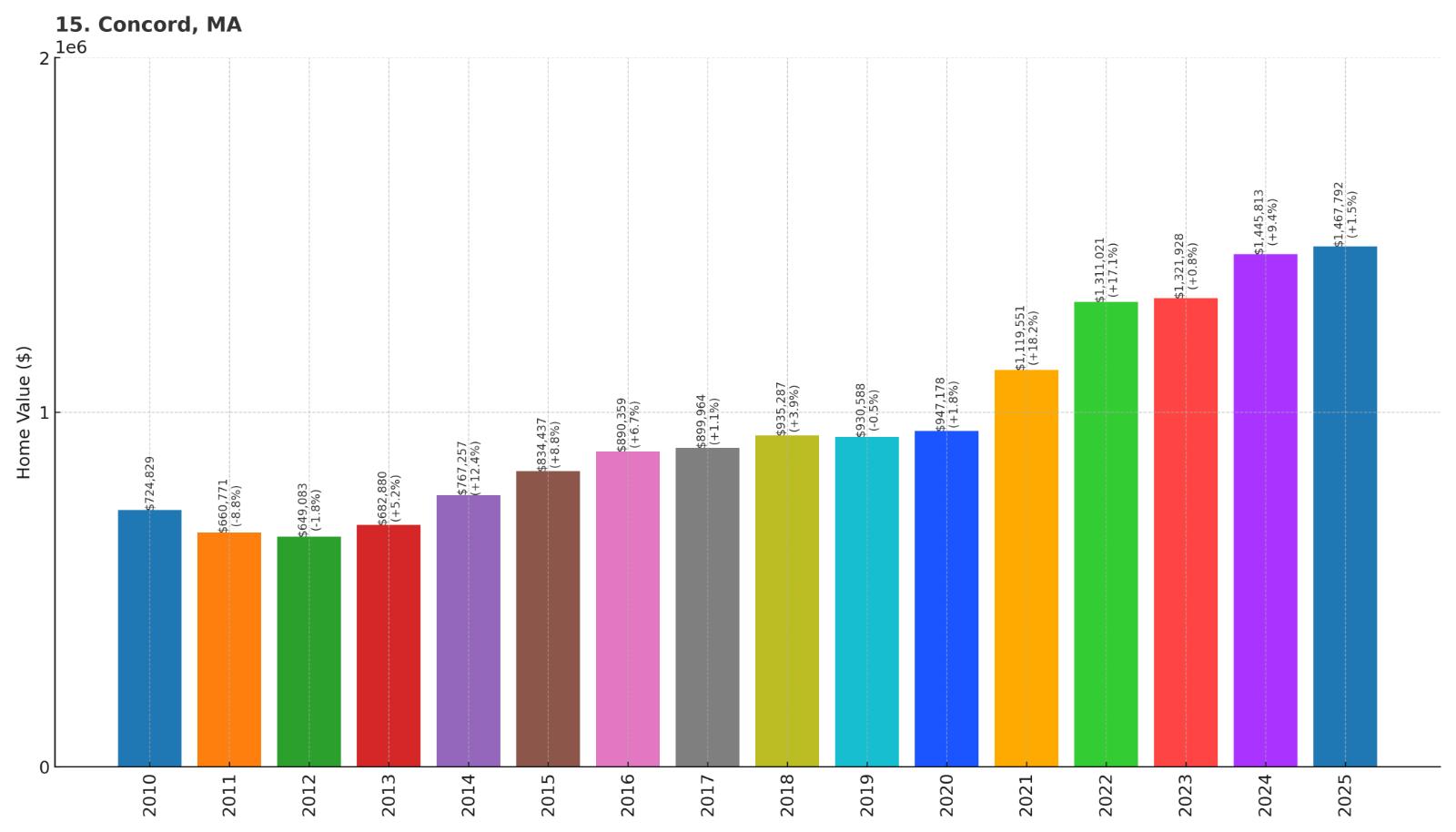
- 2010: $724,829
- 2011: $660,771
- 2012: $649,083
- 2013: $682,880
- 2014: $767,257
- 2015: $834,437
- 2016: $890,359
- 2017: $899,964
- 2018: $935,287
- 2019: $930,588
- 2020: $947,178
- 2021: $1,119,551
- 2022: $1,311,021
- 2023: $1,321,928
- 2024: $1,445,813
- 2025: $1,467,792
Concord has more than doubled since 2010, showing strong 103% appreciation to reach nearly $1.47 million by 2025. This historic MetroWest town crossed the million-dollar mark in 2021 and has continued climbing steadily. Concord’s combination of Revolutionary War history, literary heritage, and natural beauty creates unmatched appeal for buyers seeking both prestige and quality of life.
Why Concord?

Why Are People Willing to Pay So Much to Live Here? What’s Special About It?
Concord offers families the unique opportunity to live among America’s most important historical sites while enjoying excellent schools and natural beauty. The town attracts buyers seeking intellectual and cultural stimulation, with numerous historic sites, museums, and preservation areas. Residents value the combination of small-town atmosphere, rich heritage, and convenient access to Boston employment centers.
How Concord Rose to Prominence
Incorporated in 1635, Concord gained fame as the site of the first battle of the Revolutionary War at the Old North Bridge in 1775. The town later became a center of American literary culture, home to authors Ralph Waldo Emerson, Henry David Thoreau, Nathaniel Hawthorne, and Louisa May Alcott. This dual legacy of historical significance and intellectual achievement has made Concord one of America’s most prestigious small towns, attracting residents who value both heritage and education.
3 Interesting Tidbits
1. Walden Pond: Henry David Thoreau’s famous retreat and the birthplace of the American environmental movement is now a popular state reservation.
2. Orchard House: The home where Louisa May Alcott wrote “Little Women” is now a museum that attracts visitors from around the world.
3. Concord Museum: This renowned institution houses one of the world’s most important collections of Revolutionary War and American decorative arts artifacts.
14. Belmont – 128% Home Price Increase Since 2010

- 2010: $651,355
- 2011: $645,884
- 2012: $636,256
- 2013: $706,295
- 2014: $780,032
- 2015: $835,490
- 2016: $907,672
- 2017: $934,440
- 2018: $1,019,907
- 2019: $1,049,278
- 2020: $1,101,800
- 2021: $1,201,198
- 2022: $1,351,933
- 2023: $1,364,363
- 2024: $1,479,018
- 2025: $1,483,256
Belmont has shown exceptional growth with a 128% increase since 2010, reaching nearly $1.48 million by 2025. This inner suburb crossed the million-dollar threshold in 2018 and has continued climbing steadily, showing one of the strongest appreciation rates on this list. Belmont’s location adjacent to Cambridge and access to world-class educational institutions drives premium pricing.
Why Belmont?

Why Are People Willing to Pay So Much to Live Here? What’s Special About It?
Belmont offers families exceptional schools, safe neighborhoods, and convenient access to Boston, Cambridge, and major universities. The town attracts highly educated professionals who value proximity to Harvard, MIT, and other world-class institutions. Residents appreciate the suburban feel with tree-lined streets and parks while maintaining easy access to urban amenities and employment centers.
How Belmont Rose to Prominence
Originally part of Cambridge and Watertown, Belmont was incorporated as a separate town in 1859, named after Belle Monte, the estate of artist John Perkins Cushing. The community developed as a streetcar suburb in the late 1800s, attracting middle and upper-middle-class families seeking to escape Boston’s congestion. The town’s proximity to Harvard and MIT made it particularly attractive to academics and professionals, establishing its reputation as an intellectual community.
3 Interesting Tidbits
1. McLean Hospital: This renowned psychiatric hospital has been treating patients since 1818 and is a leading center for mental health research and treatment.
2. Belmont Hill School: This prestigious preparatory school for boys has educated prominent leaders in business, government, and academia since 1923.
3. Fresh Pond Reservation: Although located in Cambridge, this important watershed and recreational area borders Belmont and provides residents with extensive walking and jogging trails.
13. Needham – 73% Home Price Increase Since 2010
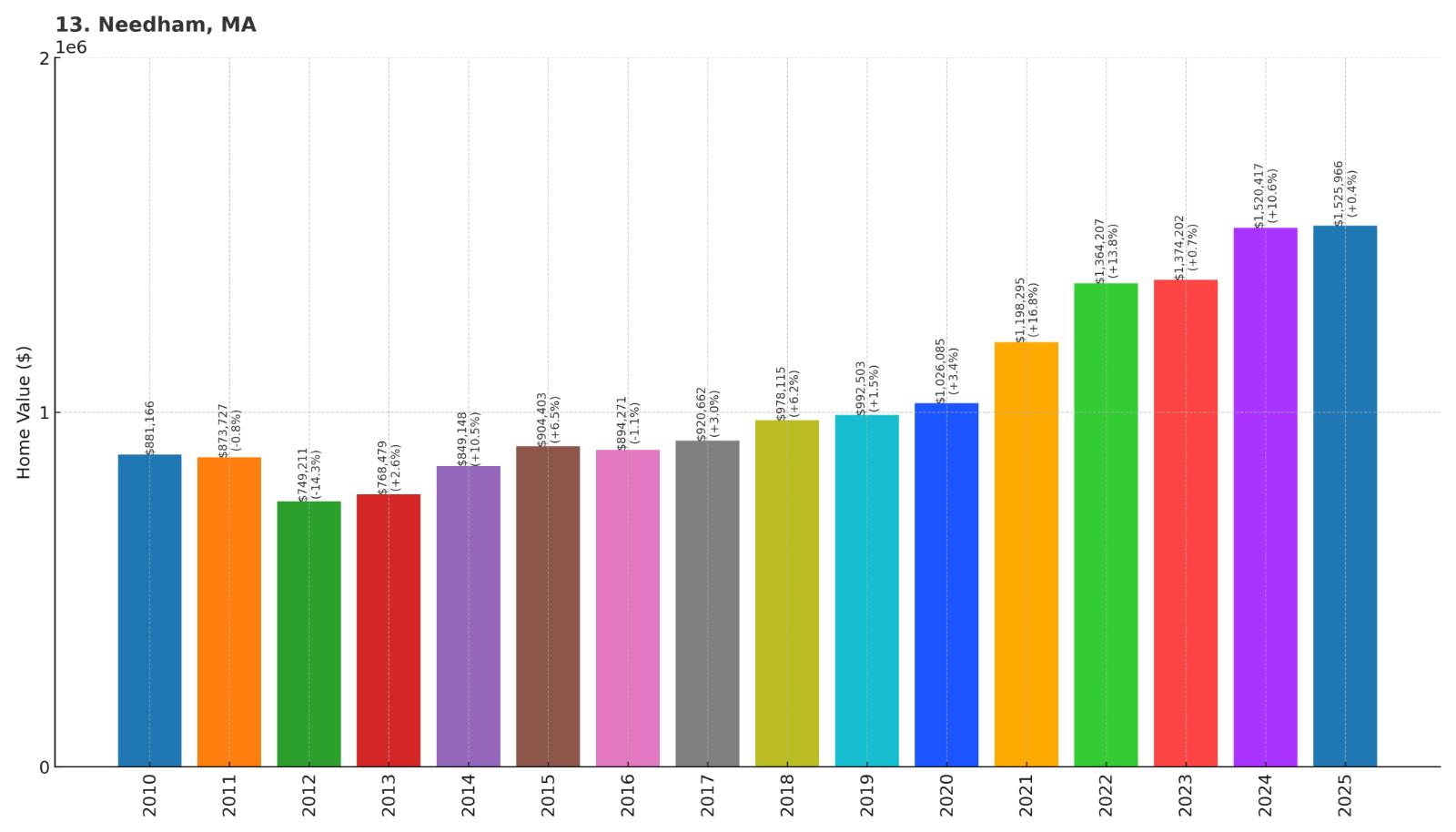
- 2010: $881,166
- 2011: $873,727
- 2012: $749,211
- 2013: $768,479
- 2014: $849,148
- 2015: $904,403
- 2016: $894,271
- 2017: $920,662
- 2018: $978,115
- 2019: $992,503
- 2020: $1,026,085
- 2021: $1,198,295
- 2022: $1,364,207
- 2023: $1,374,202
- 2024: $1,520,417
- 2025: $1,525,966
Needham has shown strong growth with a 73% increase since 2010, reaching over $1.52 million by 2025. This MetroWest community started from a high base of $881,000 in 2010 and has continued climbing steadily, crossing $1.5 million in 2024. Needham’s combination of excellent schools, convenient location, and family-friendly amenities drives consistent buyer demand.
Why Needham?

Why Are People Willing to Pay So Much to Live Here? What’s Special About It?
Needham attracts families seeking top-tier public schools, safe neighborhoods, and convenient access to Boston employment centers. The town offers excellent recreational facilities including parks, sports complexes, and golf courses alongside strong municipal services. Residents value the community’s commitment to education, family-friendly atmosphere, and proximity to major highways and public transportation.
How Needham Rose to Prominence
Incorporated in 1711 from parts of Dedham, Needham developed as an agricultural and mill town along the Charles River. The arrival of railroad service in the 1850s connected the community more closely to Boston, beginning its transformation into a residential suburb. Post-war suburban expansion established Needham as a premier family destination, with new neighborhoods, schools, and amenities that attracted upper-middle-class professionals seeking quality of life outside the city.
3 Interesting Tidbits
1. Needham Public Schools: The town’s school system consistently ranks among Massachusetts’ best, with high test scores and college acceptance rates that attract families from across the region.
2. Charles River Peninsula: This scenic area offers residents beautiful walking trails and views along the Charles River, providing natural beauty within the suburban setting.
3. TV and Film Hub: Several television shows and movies have been filmed in Needham, taking advantage of its classic New England suburban appearance.
12. Newton – 113% Home Price Increase Since 2010
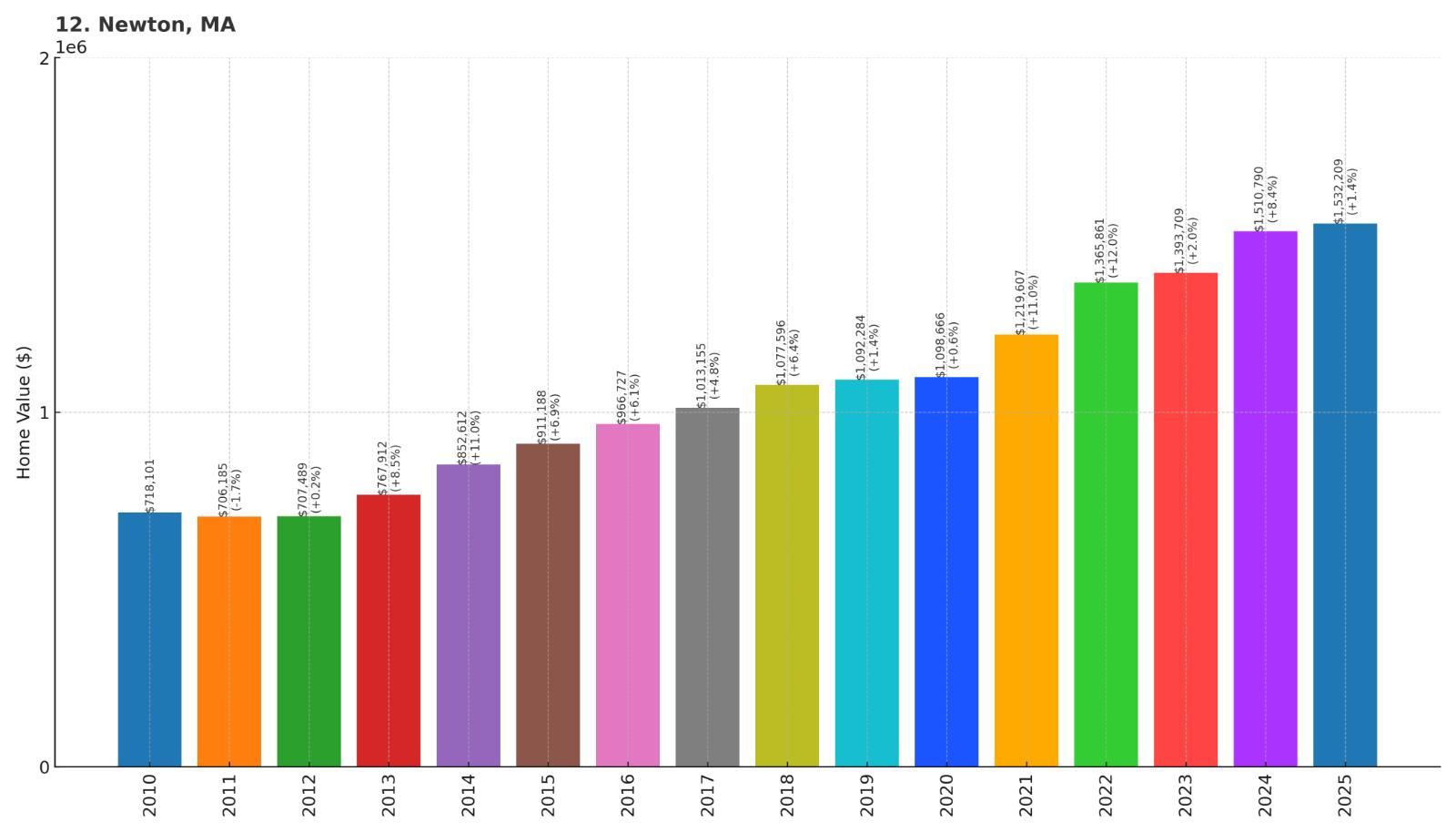
- 2010: $718,101
- 2011: $706,185
- 2012: $707,489
- 2013: $767,912
- 2014: $852,612
- 2015: $911,188
- 2016: $966,727
- 2017: $1,013,155
- 2018: $1,077,596
- 2019: $1,092,284
- 2020: $1,098,666
- 2021: $1,219,607
- 2022: $1,365,861
- 2023: $1,393,709
- 2024: $1,510,790
- 2025: $1,532,209
Newton has more than doubled since 2010, showing strong 113% appreciation to reach over $1.53 million by 2025. This inner suburb crossed the million-dollar threshold in 2017 and has continued climbing steadily. Newton’s combination of excellent schools, diverse neighborhoods, and proximity to Boston makes it one of the most desirable family communities in Massachusetts.
Why Newton?

Why Are People Willing to Pay So Much to Live Here? What’s Special About It?
Newton offers families access to some of Massachusetts’ best public schools while maintaining convenient access to Boston and Cambridge employment centers. The city’s diverse neighborhoods each have their own character, from urban villages to suburban enclaves, providing options for different family needs. Residents value the excellent municipal services, recreational facilities, and strong sense of community that comes with Newton’s long-established neighborhoods.
How Newton Rose to Prominence
Originally known as Cambridge Village, Newton was incorporated in 1688 and developed as a collection of distinct villages connected by the Charles River. The arrival of streetcar and subway service in the late 1800s established Newton as Boston’s premier streetcar suburb, attracting wealthy families who built substantial homes in tree-lined neighborhoods. The city’s commitment to education and municipal services has maintained its status as one of Greater Boston’s most prestigious residential communities.
3 Interesting Tidbits
1. The Garden City: Newton is often called “The Garden City” due to its abundance of parks, tree-lined streets, and carefully planned neighborhoods that preserve green space.
2. Newton Public Schools: The city operates one of the state’s most respected school systems, with multiple high schools serving different areas of the city.
3. Boston College: The prestigious university’s main campus is located in Newton, contributing to the city’s intellectual atmosphere and providing cultural and sporting events for residents.
11. Lincoln – 97% Home Price Increase Since 2010
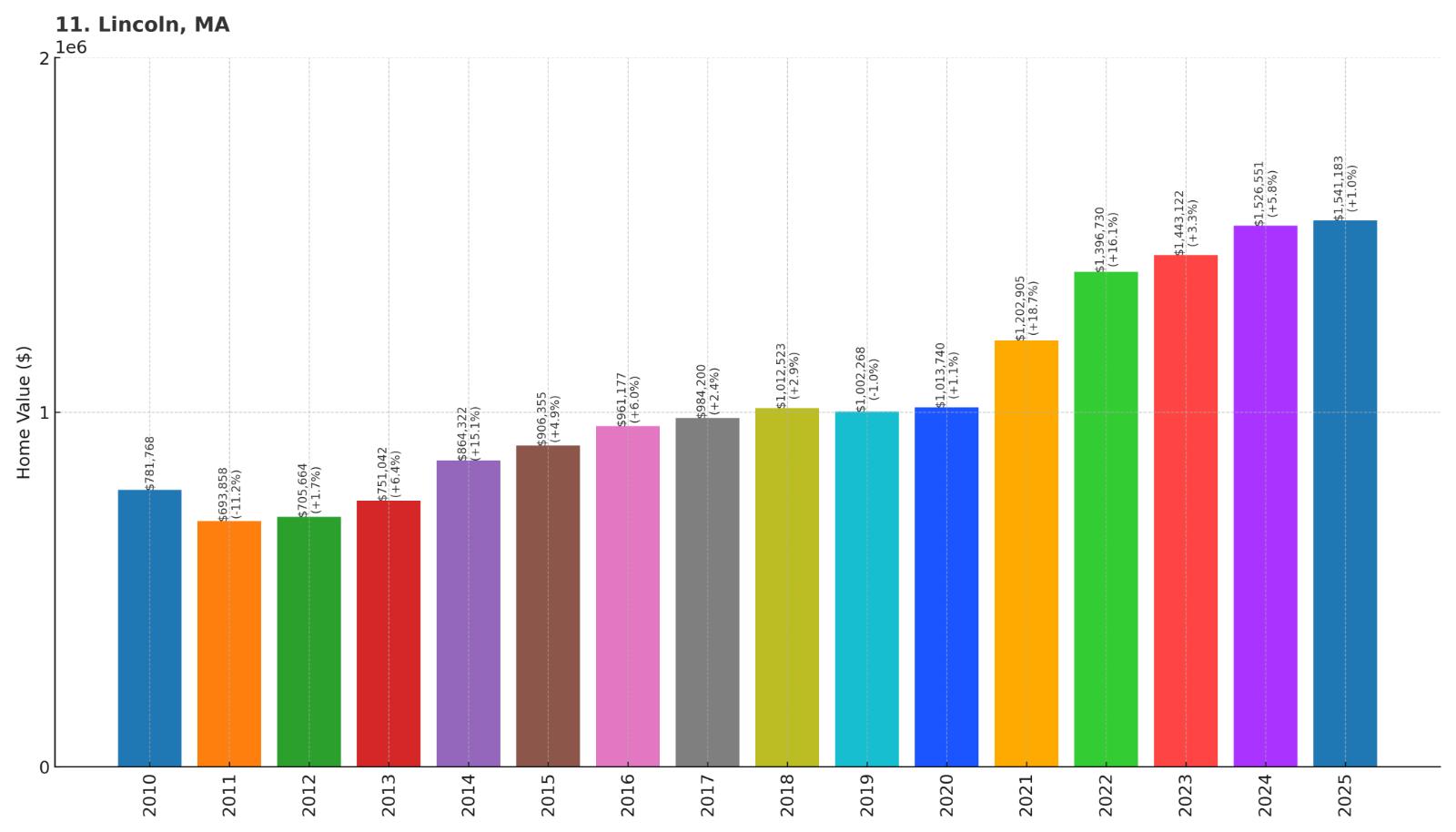
- 2010: $781,768
- 2011: $693,858
- 2012: $705,664
- 2013: $751,042
- 2014: $864,322
- 2015: $906,355
- 2016: $961,177
- 2017: $984,200
- 2018: $1,012,523
- 2019: $1,002,268
- 2020: $1,013,740
- 2021: $1,202,905
- 2022: $1,396,730
- 2023: $1,443,122
- 2024: $1,526,551
- 2025: $1,541,183
Lincoln has nearly doubled since 2010, showing strong 97% appreciation to reach over $1.54 million by 2025. This MetroWest community crossed the million-dollar threshold in 2018 and has continued climbing steadily. Lincoln’s commitment to preserving rural character while providing access to Boston-area employment drives premium pricing for its limited housing stock.
Why Lincoln?

Why Are People Willing to Pay So Much to Live Here? What’s Special About It?
Lincoln offers families the rare opportunity to live in a rural setting with large lots and conservation land while remaining within commuting distance of Boston. The town has successfully preserved over half its land area as conservation space, creating a unique environment that feels far from urban development. Residents value the excellent schools, equestrian facilities, and commitment to environmental preservation that makes Lincoln one of Massachusetts’ most exclusive rural communities.
How Lincoln Rose to Prominence
Incorporated in 1754 from parts of Concord, Lexington, and Weston, Lincoln remained primarily agricultural for over two centuries. The town’s rural character attracted wealthy Boston families in the early 1900s who built country estates and helped establish Lincoln’s tradition of land conservation. Modern zoning laws requiring large lot sizes and extensive conservation efforts have maintained Lincoln’s rural atmosphere while making it increasingly exclusive and expensive.
3 Interesting Tidbits
1. Codman Estate: This historic property, now managed by Historic New England, showcases Lincoln’s agricultural heritage and includes a working farm and formal gardens.
2. Land Conservation: Lincoln has preserved over 60% of its total land area through conservation restrictions, town forests, and protected open space.
3. Rural Roads: Many of Lincoln’s roads remain unpaved or minimally paved, maintaining the rural character that residents value and newcomers seek.
10. Winchester – 110% Home Price Increase Since 2010
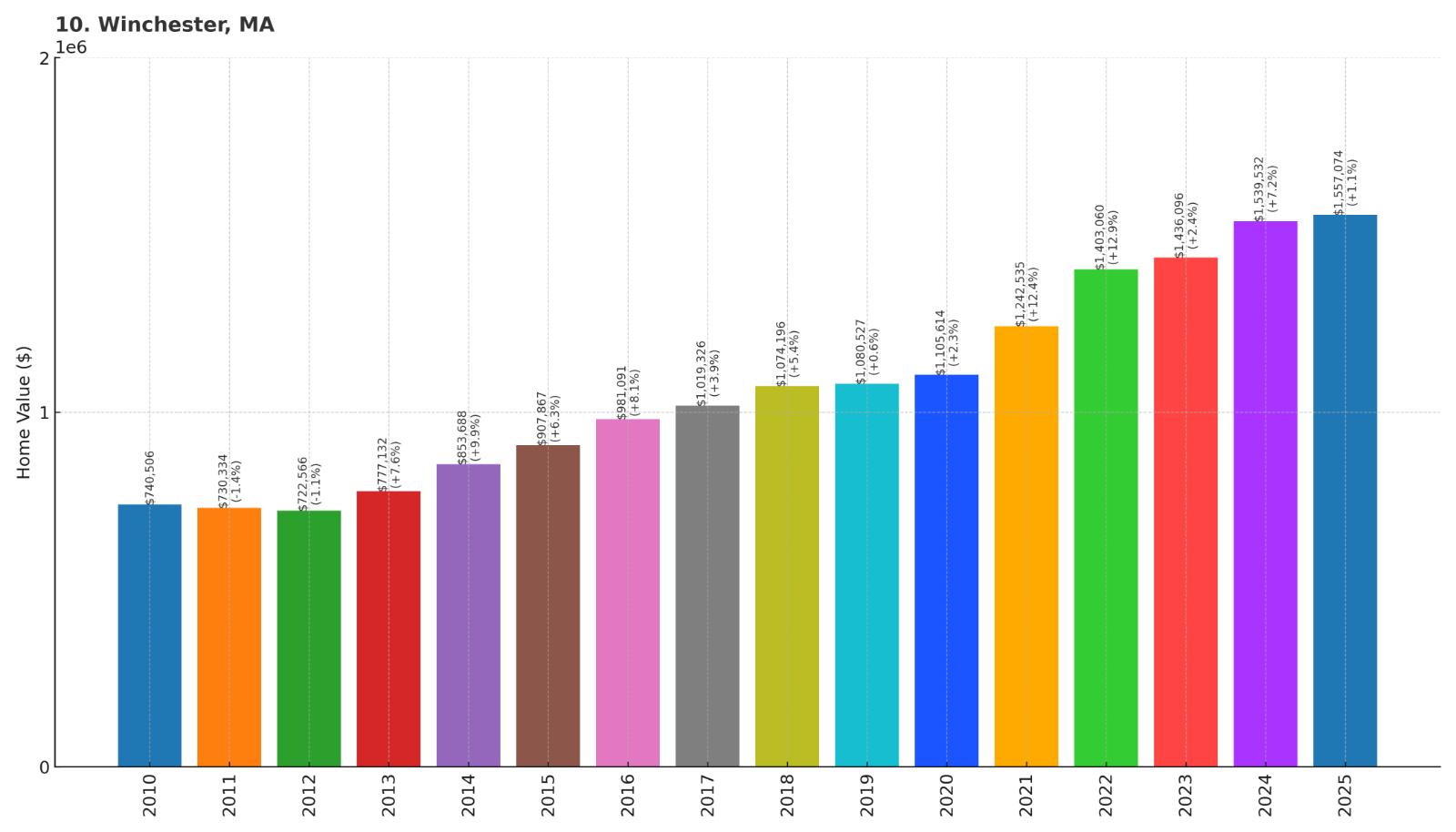
- 2010: $740,506
- 2011: $730,334
- 2012: $722,566
- 2013: $777,132
- 2014: $853,688
- 2015: $907,867
- 2016: $981,091
- 2017: $1,019,326
- 2018: $1,074,196
- 2019: $1,080,527
- 2020: $1,105,614
- 2021: $1,242,535
- 2022: $1,403,060
- 2023: $1,436,096
- 2024: $1,539,532
- 2025: $1,557,074
Winchester has more than doubled since 2010, showing strong 110% appreciation to reach over $1.55 million by 2025. This inner suburb crossed the million-dollar threshold in 2017 and has continued climbing steadily. Winchester’s combination of excellent schools, historic neighborhoods, and convenient access to Boston makes it one of the most sought-after family communities north of the city.
Why Winchester?

Why Are People Willing to Pay So Much to Live Here? What’s Special About It?
Winchester attracts families seeking top-rated public schools, safe neighborhoods, and a strong sense of community just minutes from Boston. The town offers beautiful parks, recreational facilities, and well-preserved historic architecture alongside modern amenities. Residents value the excellent municipal services, walkable downtown area, and convenient commuter rail access that makes urban employment accessible while maintaining suburban quality of life.
How Winchester Rose to Prominence
Incorporated in 1850 from parts of Cambridge, Medford, and Woburn, Winchester developed as a planned suburban community designed to attract middle and upper-class families from Boston. The town’s founders created wide tree-lined streets, parks, and municipal services that established Winchester as a model suburban community. The arrival of commuter rail service cemented its appeal to Boston professionals seeking family-friendly living outside the city.
3 Interesting Tidbits
1. Horn Pond: This scenic pond and surrounding conservation area provides residents with walking trails, fishing, and natural beauty in the heart of the community.
2. Winchester Public Schools: The town’s school system consistently ranks among the state’s best, with high test scores and college acceptance rates that attract families regionally.
3. Town Common: Winchester’s central common, surrounded by historic buildings and churches, hosts community events and serves as the heart of the downtown area.
9. Lexington – 119% Home Price Increase Since 2010
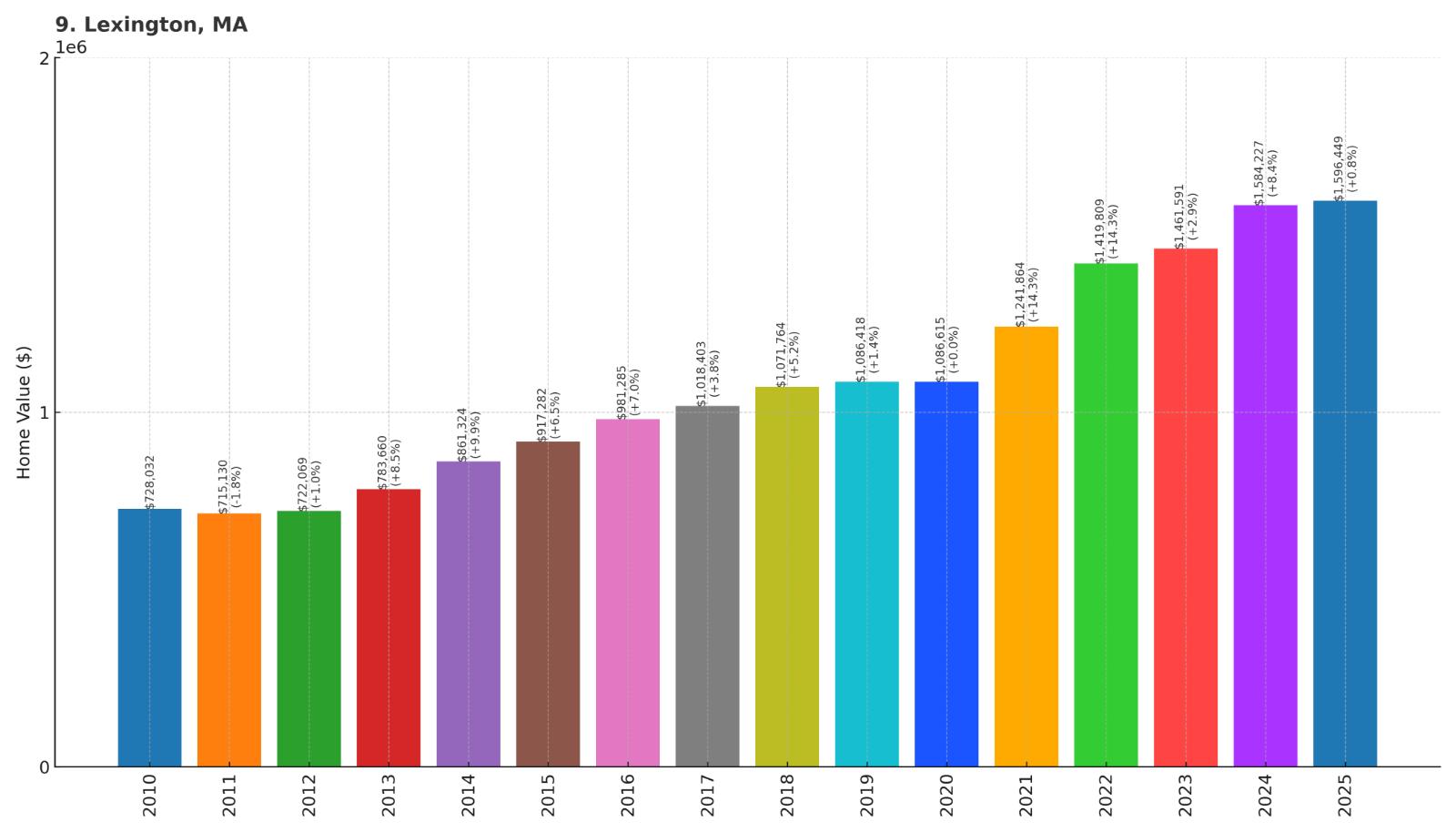
- 2010: $728,032
- 2011: $715,130
- 2012: $722,069
- 2013: $783,660
- 2014: $861,324
- 2015: $917,282
- 2016: $981,285
- 2017: $1,018,403
- 2018: $1,071,764
- 2019: $1,086,418
- 2020: $1,086,615
- 2021: $1,241,864
- 2022: $1,419,809
- 2023: $1,461,591
- 2024: $1,584,227
- 2025: $1,596,449
Lexington has more than doubled since 2010, showing exceptional 119% appreciation to reach nearly $1.6 million by 2025. This historic MetroWest town crossed the million-dollar threshold in 2017 and has continued climbing rapidly. According to current Zillow data, Lexington’s home values are up 0.7% over the past year, reflecting the sustained demand for this prestigious community.
Why Lexington?

Why Are People Willing to Pay So Much to Live Here? What’s Special About It?
Lexington combines America’s most important Revolutionary War history with some of Massachusetts’ best public schools and family amenities. The town attracts highly educated professionals who value both educational excellence and cultural significance. Families are drawn to the safe neighborhoods, excellent recreational facilities, and the prestige of living where American independence began while maintaining convenient access to Boston-area employment.
How Lexington Rose to Prominence
Incorporated in 1713, Lexington gained worldwide fame as the site where “the shot heard ’round the world” was fired on April 19, 1775, beginning the Revolutionary War. This historical significance established Lexington as an important American landmark, while its location and quality of life attracted families seeking suburban living. Post-war development and the town’s commitment to education transformed Lexington into one of Massachusetts’ most prestigious residential communities.
3 Interesting Tidbits
1. Battle Green: The town common where the first shot of the Revolutionary War was fired is now a National Historic Landmark surrounded by historic buildings and monuments.
2. Minute Man National Historical Park: This park preserves the route of the British retreat from Concord through Lexington, offering residents and visitors hiking trails through American history.
3. Cary Memorial Library: This beautiful 1906 library serves as both a community resource and architectural landmark that reflects Lexington’s commitment to education and culture.
8. West Tisbury – 143% Home Price Increase Since 2010
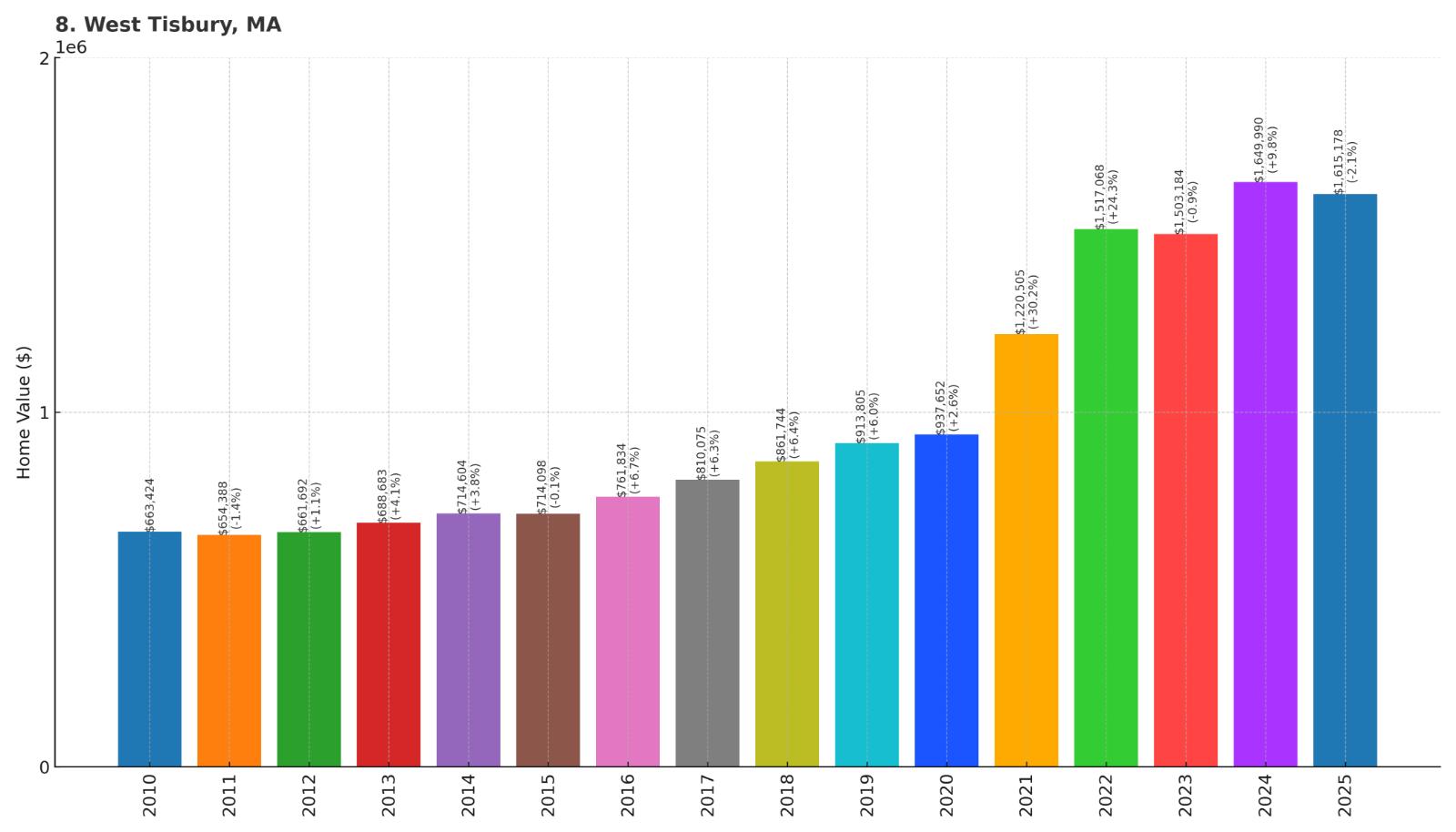
- 2010: $663,424
- 2011: $654,388
- 2012: $661,692
- 2013: $688,683
- 2014: $714,604
- 2015: $714,098
- 2016: $761,834
- 2017: $810,075
- 2018: $861,744
- 2019: $913,805
- 2020: $937,652
- 2021: $1,220,505
- 2022: $1,517,068
- 2023: $1,503,184
- 2024: $1,649,990
- 2025: $1,615,178
West Tisbury has shown dramatic growth with a 143% increase since 2010, reaching over $1.61 million by 2025. This Martha’s Vineyard community experienced explosive pandemic-era growth, jumping from $937,000 in 2020 to over $1.2 million by 2021. West Tisbury’s rural character and island exclusivity continue to drive premium pricing despite recent moderation.
Why West Tisbury?

Why Are People Willing to Pay So Much to Live Here? What’s Special About It?
West Tisbury offers the most rural and private setting on Martha’s Vineyard, with rolling hills, conservation land, and agricultural areas that preserve the island’s historic character. Buyers are attracted to the large lots, privacy, and natural beauty that provide an escape from urban life. The town’s commitment to preserving open space and limiting development makes property here increasingly scarce and valuable.
How West Tisbury Rose to Prominence
Incorporated in 1892 when it separated from Tisbury, West Tisbury was established to maintain the rural, agricultural character that residents valued. The town developed around farming and remained largely undeveloped compared to other Vineyard communities. This preservation of rural landscape, combined with the island’s growing popularity as a summer destination, has made West Tisbury increasingly desirable for those seeking privacy and natural beauty.
3 Interesting Tidbits
1. Alley’s General Store: This historic country store has been serving the community since 1858 and remains a gathering place for both residents and visitors.
2. Agricultural Society: West Tisbury maintains an active agricultural fair each August, celebrating the farming heritage that still defines much of the town.
3. Conservation Land: The town has preserved thousands of acres of open space and conservation land, maintaining its rural character while increasing property values for remaining developable lots.
7. Aquinnah – 99% Home Price Increase Since 2010
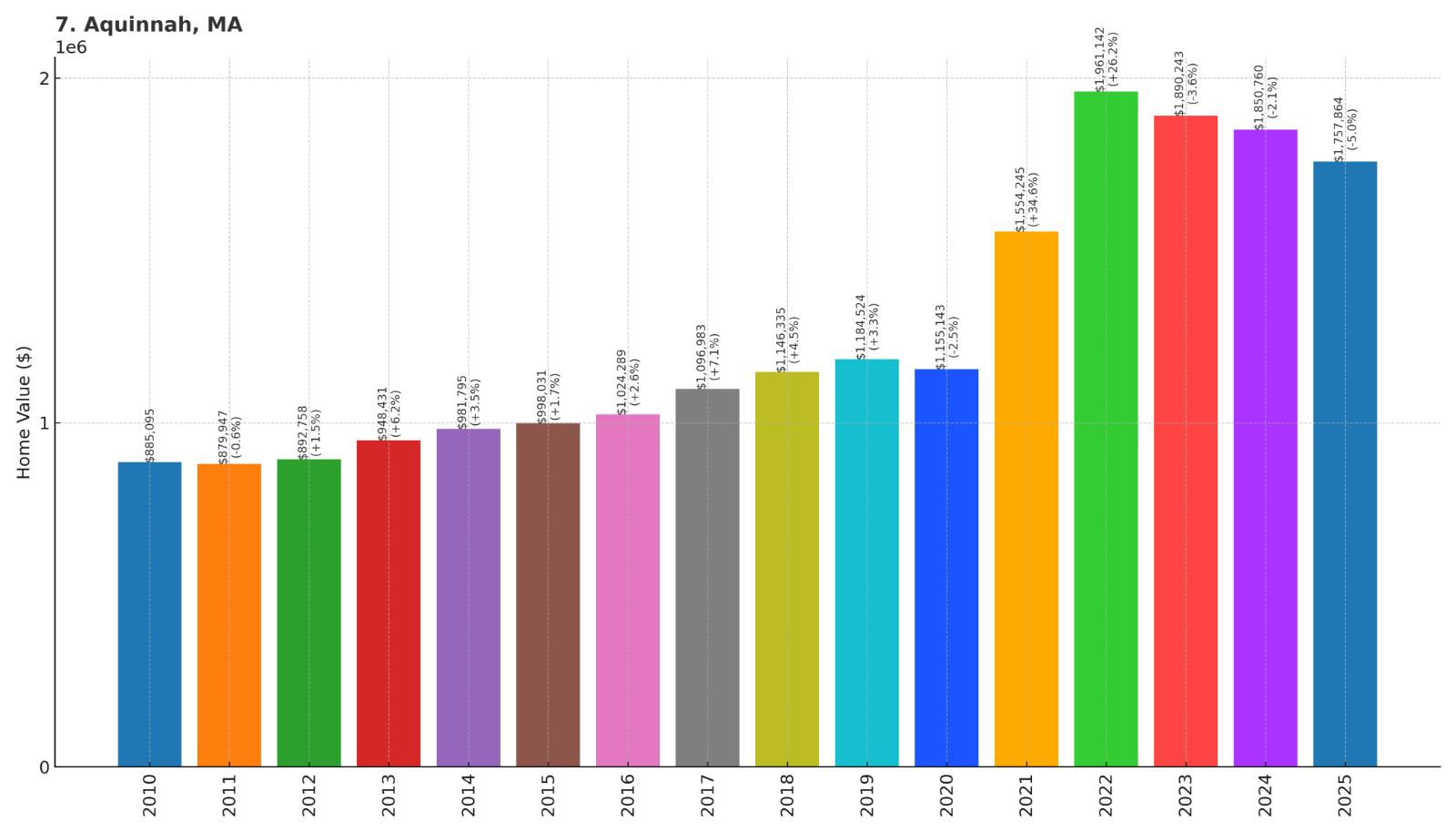
- 2010: $885,095
- 2011: $879,947
- 2012: $892,758
- 2013: $948,431
- 2014: $981,795
- 2015: $998,031
- 2016: $1,024,289
- 2017: $1,096,983
- 2018: $1,146,335
- 2019: $1,184,524
- 2020: $1,155,143
- 2021: $1,554,245
- 2022: $1,961,142
- 2023: $1,890,243
- 2024: $1,850,760
- 2025: $1,757,864
Aquinnah has nearly doubled since 2010, showing 99% appreciation to reach $1.76 million by 2025. This Martha’s Vineyard community started from a high base near $885,000 and experienced dramatic pandemic-era volatility, peaking near $2 million in 2022. Aquinnah’s spectacular cliffs and exclusive location continue to command premium pricing despite recent moderation.
Why Aquinnah?

Why Are People Willing to Pay So Much to Live Here? What’s Special About It?
Aquinnah offers unparalleled natural beauty with its famous multicolored cliffs, pristine beaches, and sweeping ocean views. The town provides the ultimate in privacy and exclusivity on Martha’s Vineyard’s most remote tip. Buyers are drawn to the spectacular scenery, Native American cultural heritage, and the prestige of owning property in one of New England’s most iconic and protected landscapes.
How Aquinnah Rose to Prominence
Originally known as Gay Head until 1997, Aquinnah was renamed to honor the Wampanoag people who have lived here for thousands of years. The town incorporated in 1870 and has remained the most rural and undeveloped area of Martha’s Vineyard. The famous clay cliffs, designated a National Natural Landmark, and the historic lighthouse have made Aquinnah a destination for visitors while limiting development and increasing property values.
3 Interesting Tidbits
1. Gay Head Cliffs: These spectacular 150-foot multicolored clay cliffs are a National Natural Landmark and one of Martha’s Vineyard’s most photographed sites.
2. Wampanoag Heritage: Aquinnah is home to the Wampanoag Tribe of Gay Head, who have maintained their cultural presence here for over 10,000 years.
3. Aquinnah Light: This historic lighthouse, built in 1856, sits atop the famous cliffs and serves as both a working navigational aid and tourist attraction.
6. Dover – 79% Home Price Increase Since 2010
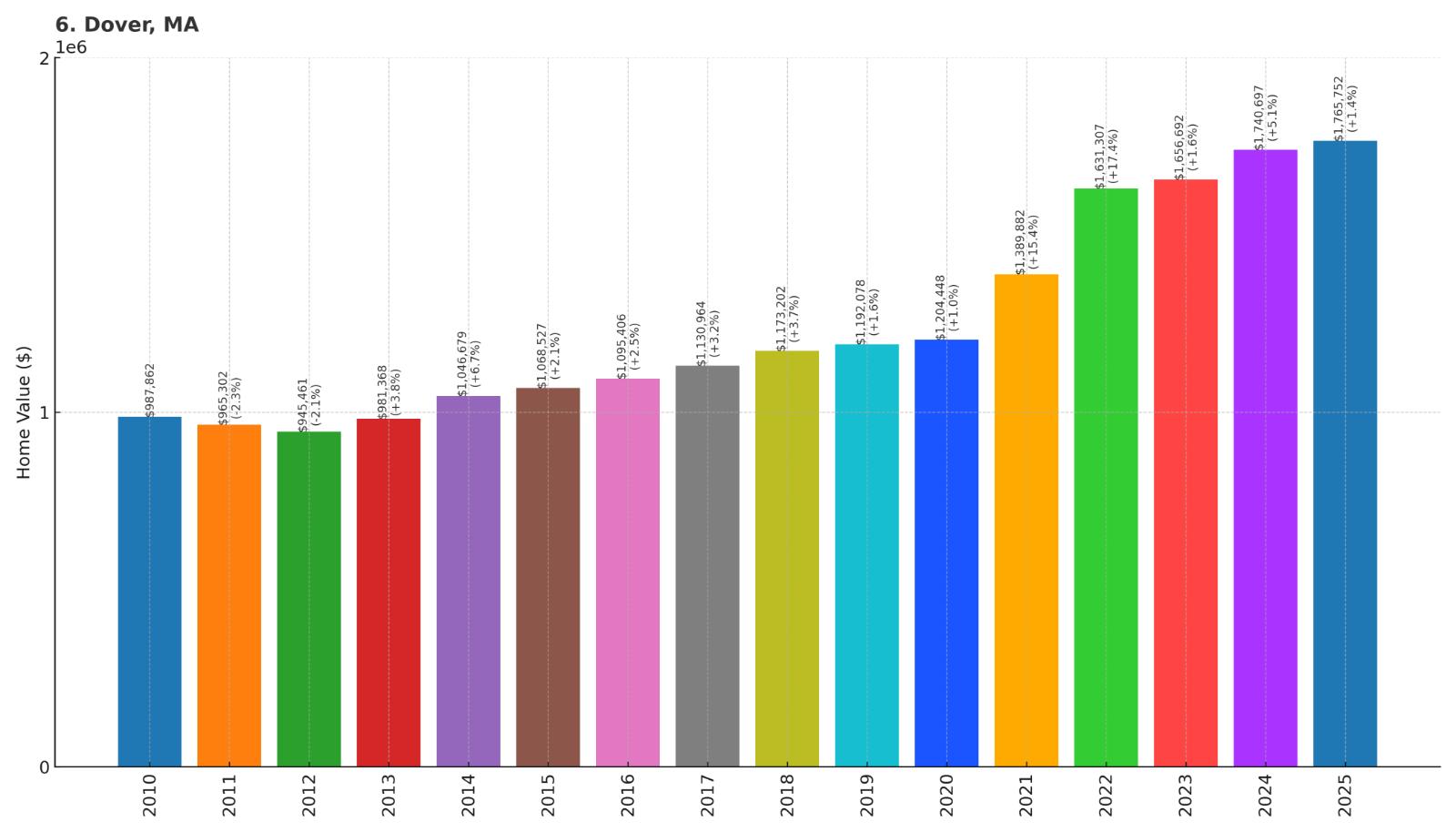
- 2010: $987,862
- 2011: $965,302
- 2012: $945,461
- 2013: $981,368
- 2014: $1,046,679
- 2015: $1,068,527
- 2016: $1,095,406
- 2017: $1,130,964
- 2018: $1,173,202
- 2019: $1,192,078
- 2020: $1,204,448
- 2021: $1,389,882
- 2022: $1,631,307
- 2023: $1,656,692
- 2024: $1,740,697
- 2025: $1,765,752
Dover has shown solid growth with a 79% increase since 2010, reaching $1.77 million by 2025. This MetroWest community started from a high base near $988,000 and has continued climbing steadily, showing particular strength during the pandemic years. Dover’s combination of rural character, equestrian facilities, and proximity to Boston drives consistent demand from affluent families.
Why Dover?

Why Are People Willing to Pay So Much to Live Here? What’s Special About It?
Dover offers families the opportunity to live on large estates with equestrian facilities while maintaining convenient access to Boston employment centers. The town has successfully preserved its rural character through large-lot zoning and conservation efforts that create a countryside atmosphere. Residents value the excellent schools, horse-friendly environment, and the prestige of living in one of Massachusetts’ most exclusive communities.
How Dover Rose to Prominence
Incorporated in 1836 from parts of Dedham, Medfield, Natick, and Needham, Dover was designed from the beginning as a rural residential community for Boston’s wealthy families. The town’s founders established large lot requirements and agricultural zoning that preserved open space and attracted residents seeking country estates. This vision of controlled development and environmental preservation has made Dover increasingly exclusive and expensive over time.
3 Interesting Tidbits
1. Horse Country: Dover maintains numerous equestrian facilities, riding trails, and horse farms that preserve its agricultural heritage and attract equestrian enthusiasts.
2. Caryl Park: This 64-acre town park includes hiking trails, sports fields, and the historic Caryl House, providing recreation and preserving local history.
3. Conservation Land: Dover has preserved over 1,600 acres of conservation land through the efforts of the Dover Land Conservation Trust, maintaining rural character while increasing property values.
5. Edgartown – 163% Home Price Increase Since 2010
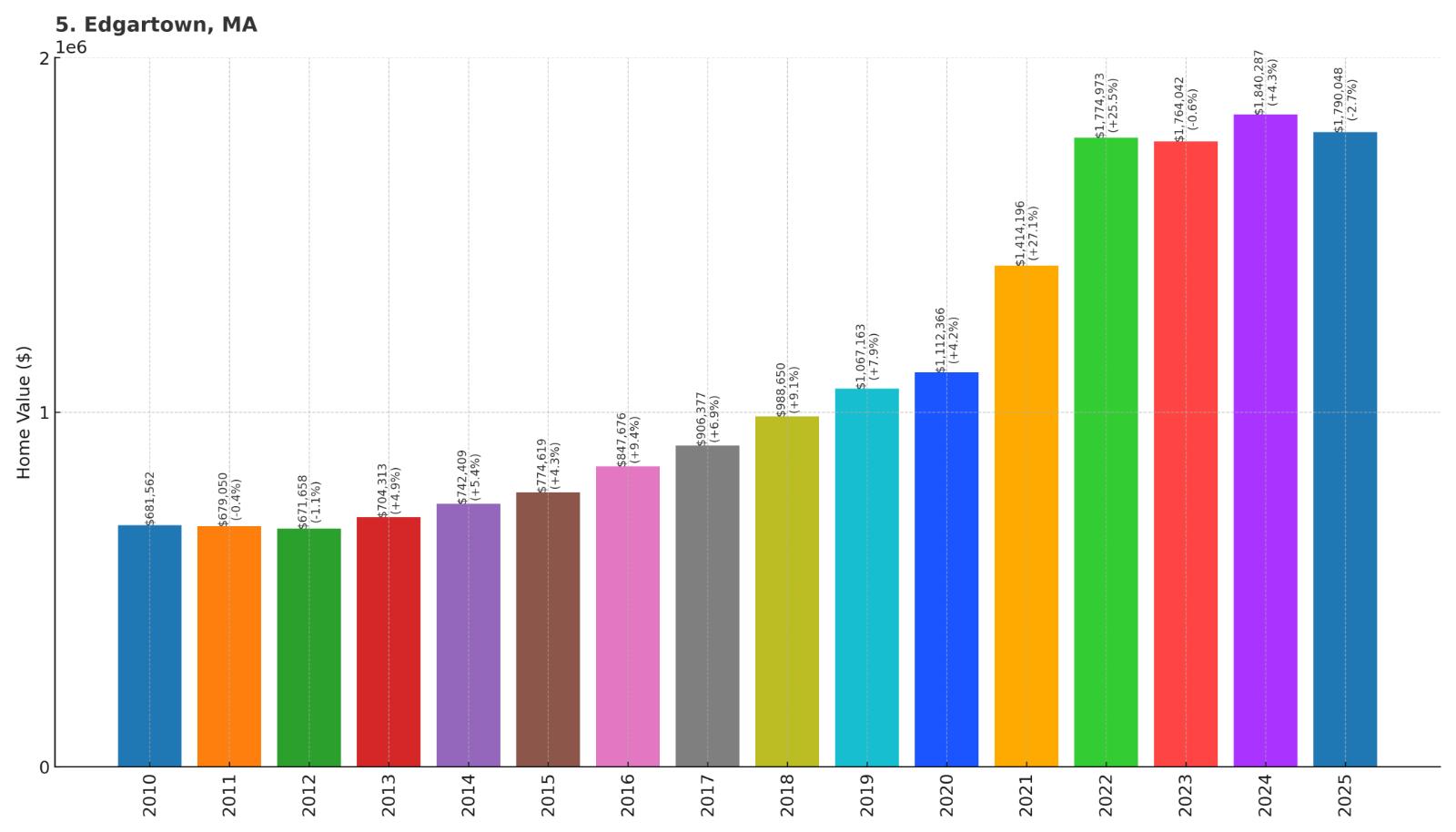
- 2010: $681,562
- 2011: $679,050
- 2012: $671,658
- 2013: $704,313
- 2014: $742,409
- 2015: $774,619
- 2016: $847,676
- 2017: $906,377
- 2018: $988,650
- 2019: $1,067,163
- 2020: $1,112,366
- 2021: $1,414,196
- 2022: $1,774,973
- 2023: $1,764,042
- 2024: $1,840,287
- 2025: $1,790,048
Edgartown has shown the most dramatic appreciation on Martha’s Vineyard with a 163% increase since 2010, reaching $1.79 million by 2025. This historic island community experienced explosive pandemic growth, jumping from $1.11 million in 2020 to over $1.4 million by 2021. Edgartown’s combination of historic charm, pristine harbor, and exclusive island location continues to drive premium pricing.
Why Edgartown?

Why Are People Willing to Pay So Much to Live Here? What’s Special About It?
Edgartown offers the perfect combination of Martha’s Vineyard’s most historic architecture, pristine harbor, and upscale amenities. The town attracts buyers seeking the ultimate New England coastal lifestyle with world-class sailing, dining, and cultural opportunities. Residents and seasonal owners value the preserved 19th-century whaling captain houses, exclusive yacht club atmosphere, and prestige of living in Martha’s Vineyard’s most sophisticated community.
How Edgartown Rose to Prominence
Incorporated in 1671, Edgartown became the center of Martha’s Vineyard’s whaling industry in the 18th and 19th centuries, with sea captains building grand homes that still define the town’s character. The decline of whaling was offset by the rise of tourism as wealthy families discovered the island’s beauty. Edgartown’s preserved architecture and sophisticated amenities established it as Martha’s Vineyard’s premier resort destination, attracting seasonal residents who drive up property values.
3 Interesting Tidbits
1. Whaling Heritage: Edgartown’s downtown features dozens of perfectly preserved 19th-century sea captain houses that showcase the wealth generated by the whaling industry.
2. Chappaquiddick Island: Connected to Edgartown by a small ferry, “Chappy” provides residents with additional beaches, conservation areas, and privacy.
3. Edgartown Yacht Club: Founded in 1905, this prestigious club hosts major sailing events and serves as a social center for the island’s most affluent residents and visitors.
4. Wellesley – 103% Home Price Increase Since 2010
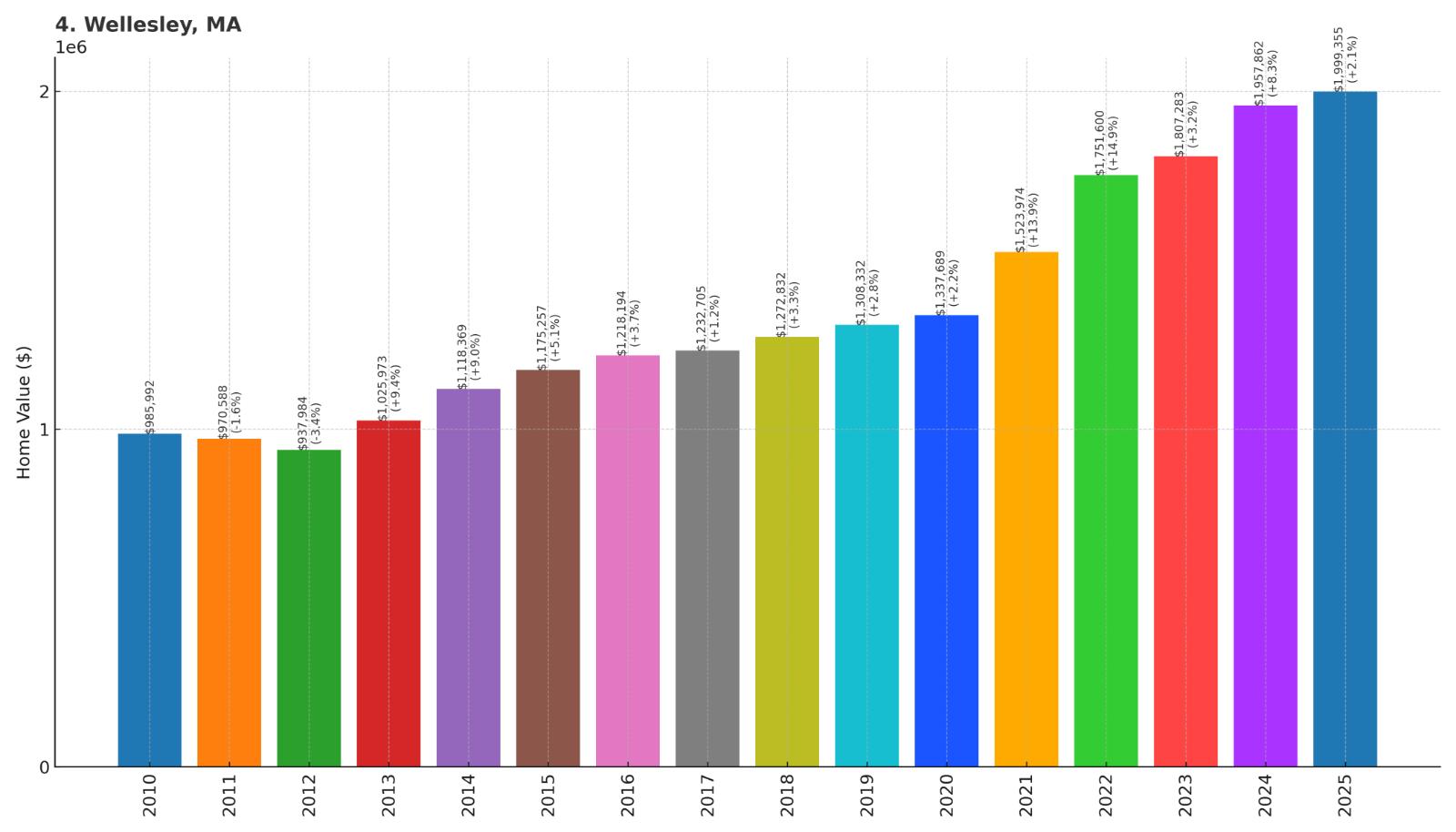
- 2010: $985,992
- 2011: $970,588
- 2012: $937,984
- 2013: $1,025,973
- 2014: $1,118,369
- 2015: $1,175,257
- 2016: $1,218,194
- 2017: $1,232,705
- 2018: $1,272,832
- 2019: $1,308,332
- 2020: $1,337,689
- 2021: $1,523,974
- 2022: $1,751,600
- 2023: $1,807,283
- 2024: $1,957,862
- 2025: $1,999,355
Wellesley has more than doubled since 2010, showing strong 103% appreciation to reach nearly $2 million by 2025. This prestigious MetroWest town started from a high base near $986,000 and has continued climbing steadily, approaching the $2 million threshold. Wellesley consistently ranks among the wealthiest communities in Massachusetts and the nation, with a per capita income of $113,079 and home prices among the most expensive in America.
Why Wellesley?

Why Are People Willing to Pay So Much to Live Here? What’s Special About It?
Wellesley attracts the most affluent families seeking world-class education, with both excellent public schools and prestigious colleges including Wellesley College and Babson College. The town offers elegant neighborhoods with historic architecture, beautiful parks, and upscale shopping and dining. Located approximately 17 miles southwest of Boston, Wellesley provides convenient access to the city while maintaining its affluent country-style suburban character.
How Wellesley Rose to Prominence
Incorporated in 1881 from parts of Needham, Wellesley was planned as an upscale residential community around the newly founded Wellesley College. The town’s founders created wide tree-lined streets, parks, and cultural amenities that attracted Boston’s wealthiest families. The majority of homes were built in colonial style prior to 1939, with spacious estates developed to co-exist with natural elements rather than clearing land for cookie-cutter developments.
3 Interesting Tidbits
1. Wellesley College: This prestigious women’s college, founded in 1870, has educated prominent leaders including Hillary Clinton and Madeleine Albright, contributing to the town’s intellectual atmosphere.
2. Babson College: Ranked number one nationally for entrepreneurship education for over a decade, this business school attracts students and faculty who enhance the community’s economic sophistication.
3. Garden in the Woods: This 45-acre botanical garden showcases native New England plants and serves as a research and education center that adds to Wellesley’s cultural amenities.
3. Weston – 94% Home Price Increase Since 2010
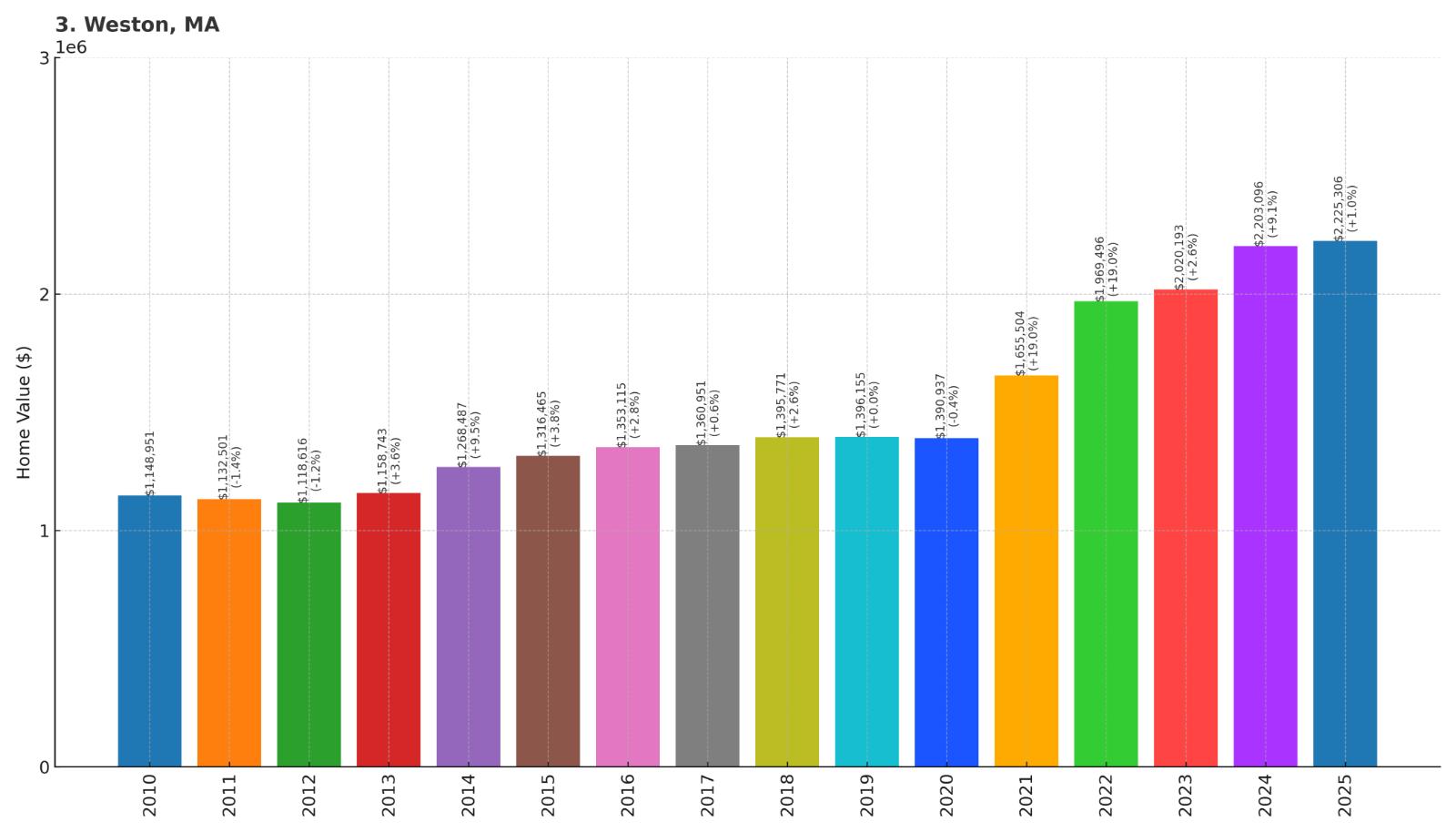
- 2010: $1,148,951
- 2011: $1,132,501
- 2012: $1,118,616
- 2013: $1,158,743
- 2014: $1,268,487
- 2015: $1,316,465
- 2016: $1,353,115
- 2017: $1,360,951
- 2018: $1,395,771
- 2019: $1,396,155
- 2020: $1,390,937
- 2021: $1,655,504
- 2022: $1,969,496
- 2023: $2,020,193
- 2024: $2,203,096
- 2025: $2,225,306
Weston has shown solid growth with a 94% increase since 2010, reaching $2.23 million by 2025. This exclusive MetroWest community started from the highest base on this list at $1.15 million and has continued climbing steadily, crossing the $2 million threshold in 2023. Weston’s commitment to preserving rural character while providing luxury amenities drives consistent demand from the region’s most affluent families.
Why Weston?

Why Are People Willing to Pay So Much to Live Here? What’s Special About It?
Weston offers the ultimate in suburban luxury with large estates, pristine conservation land, and top-tier schools in a setting that feels far from urban development. The town attracts the region’s wealthiest families who value privacy, natural beauty, and exclusivity while maintaining access to Boston employment centers. Residents appreciate the careful balance between luxury living and environmental preservation that makes Weston unique among affluent suburbs.
How Weston Rose to Prominence
Incorporated in 1713, Weston remained primarily agricultural until the 20th century when wealthy Boston families began building country estates on its rolling hills and woodland areas. The town’s commitment to large-lot zoning and conservation has preserved its rural character while attracting increasingly affluent residents. This controlled development and focus on environmental preservation has made Weston one of the most exclusive and expensive communities in Massachusetts.
3 Interesting Tidbits
1. Case Estates: This 60-acre property features formal gardens, greenhouses, and educational programs managed by the Weston Forest and Trail Association.
2. Conservation Land: Weston has preserved over 2,000 acres of conservation land, including forests, wetlands, and trail systems that maintain the town’s rural character.
3. Regis College: This private Catholic university adds cultural and educational opportunities to the community while contributing to Weston’s intellectual atmosphere.
2. Chilmark – 67% Home Price Increase Since 2017
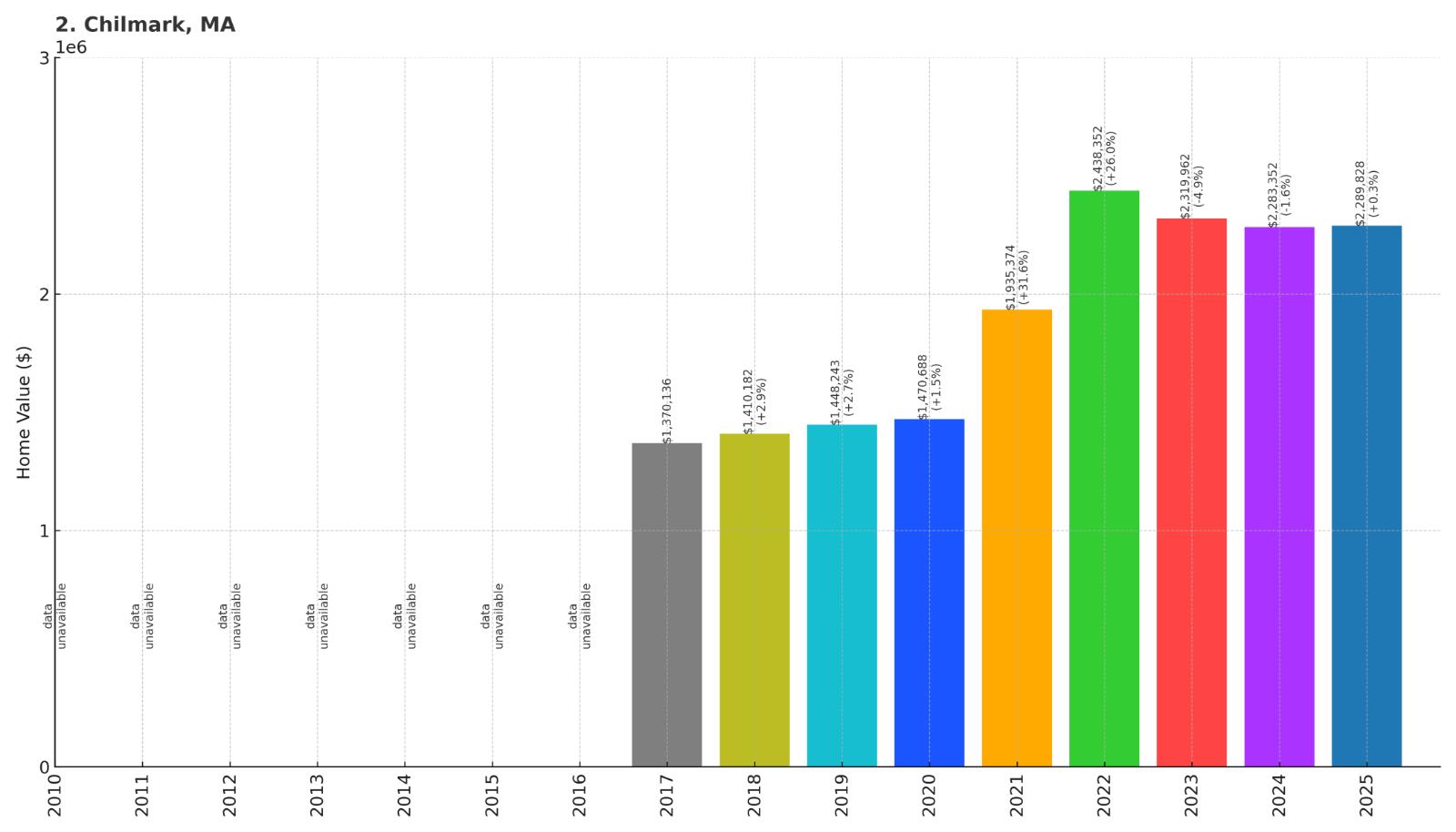
- 2010: N/A
- 2011: N/A
- 2012: N/A
- 2013: N/A
- 2014: N/A
- 2015: N/A
- 2016: N/A
- 2017: $1,370,136
- 2018: $1,410,182
- 2019: $1,448,243
- 2020: $1,470,688
- 2021: $1,935,374
- 2022: $2,438,352
- 2023: $2,319,962
- 2024: $2,283,352
- 2025: $2,289,828
Chilmark shows a 67% increase since data became available in 2017, reaching $2.29 million by 2025. This Martha’s Vineyard community experienced dramatic pandemic volatility, peaking near $2.44 million in 2022 before moderating slightly. With limited data availability, Chilmark represents one of the most exclusive and restricted real estate markets in Massachusetts, where property transactions are rare and values reflect extreme scarcity.
Why Chilmark?

Why Are People Willing to Pay So Much to Live Here? What’s Special About It?
Chilmark offers the ultimate in Martha’s Vineyard exclusivity with rolling hills, stone walls, and some of the island’s most spectacular ocean views. The town attracts buyers seeking maximum privacy and natural beauty on large lots that preserve the island’s agricultural heritage. Property ownership here represents the pinnacle of New England coastal living, with strict conservation regulations ensuring that development remains minimal and character is preserved.
How Chilmark Rose to Prominence
Incorporated in 1694, Chilmark remained a rural farming and fishing community for centuries, with stone walls and pastures defining its landscape. The town’s remote location and commitment to conservation have limited development while attracting celebrities and wealthy families seeking privacy. This combination of natural beauty, exclusivity, and restricted development has made Chilmark one of America’s most expensive and sought-after rural communities.
3 Interesting Tidbits
1. Stone Walls: Chilmark’s landscape is defined by miles of historic stone walls built by farmers centuries ago, creating one of New England’s most iconic rural scenes.
2. Lucy Vincent Beach: This private beach, restricted to residents only, is considered one of Martha’s Vineyard’s most beautiful and exclusive coastal areas.
3. Menemsha: This working fishing village within Chilmark maintains its authentic character and provides some of the island’s best seafood and sunset views.
1. Nantucket – 148% Home Price Increase Since 2010
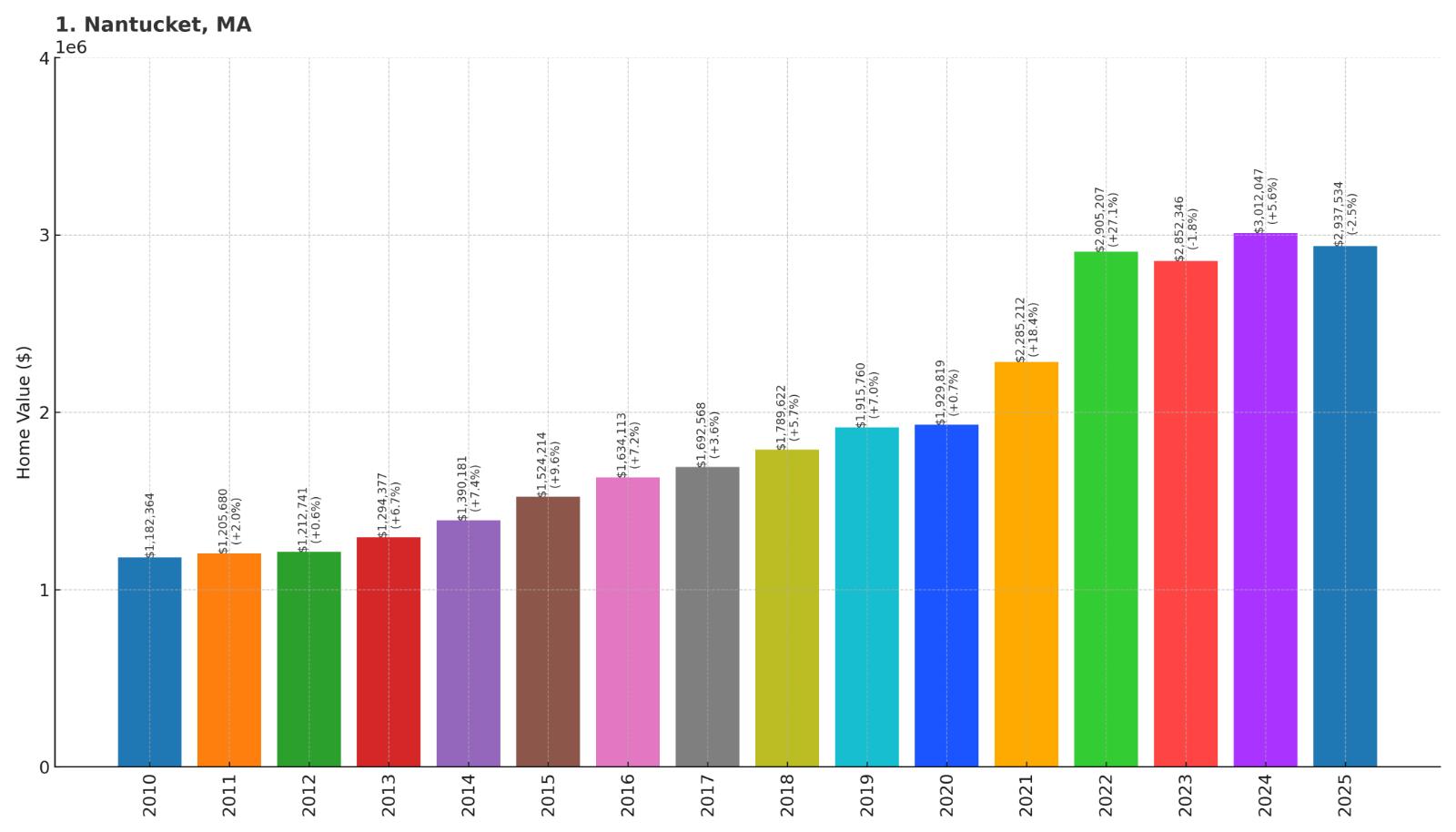
- 2010: $1,182,364
- 2011: $1,205,680
- 2012: $1,212,741
- 2013: $1,294,377
- 2014: $1,390,181
- 2015: $1,524,214
- 2016: $1,634,113
- 2017: $1,692,568
- 2018: $1,789,622
- 2019: $1,915,760
- 2020: $1,929,819
- 2021: $2,285,212
- 2022: $2,905,207
- 2023: $2,852,346
- 2024: $3,012,047
- 2025: $2,937,534
Nantucket leads Massachusetts with a 148% increase since 2010, reaching nearly $2.94 million by 2025. This exclusive island community started from a high base of $1.18 million and has experienced dramatic growth, peaking over $3 million in 2024. Current market data shows median listing prices around $3.2-$4 million, with some properties selling for over $40 million, making Nantucket one of America’s most expensive real estate markets.
Why Nantucket?

Why Are People Willing to Pay So Much to Live Here? What’s Special About It?
Nantucket represents the pinnacle of New England coastal living with its pristine beaches, historic cobblestone streets, and perfectly preserved 19th-century architecture. The island offers complete exclusivity and privacy, accessible only by ferry or private aircraft, creating a unique retreat from mainland life. Buyers are drawn to the world-class sailing, dining, and cultural amenities alongside the prestige of owning property in America’s most famous island resort community.
How Nantucket Rose to Prominence
Originally inhabited by the Wampanoag people, Nantucket was settled by English colonists in 1659 and became the world’s whaling capital by the 18th century. The wealth from whaling built the magnificent homes and cobblestone streets that define downtown Nantucket today. When whaling declined, the island reinvented itself as an exclusive summer destination, with strict historic preservation ensuring that its unique character remained intact while property values soared.
3 Interesting Tidbits
1. Historic District: Nantucket’s entire downtown is a National Historic Landmark, with over 800 pre-1850 structures creating America’s most complete historic seaport.
2. Whaling Museum: The island’s world-renowned whaling museum houses the largest collection of whaling artifacts and tells the story of Nantucket’s role as the world’s whaling capital.
3. Strict Preservation: Nantucket’s Historic District Commission maintains some of America’s strictest building codes, ensuring that new construction matches the island’s historic character and preserving property values.


